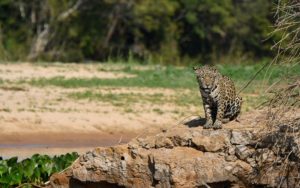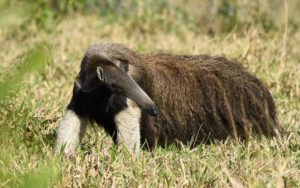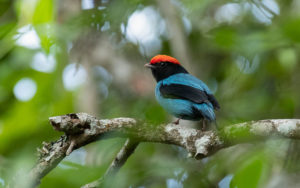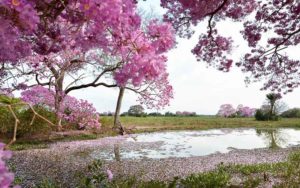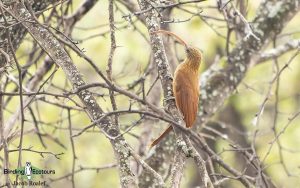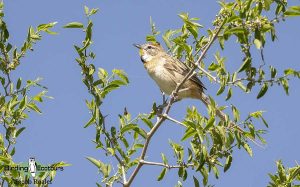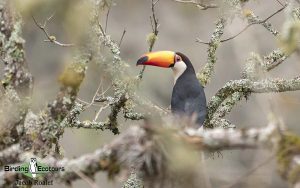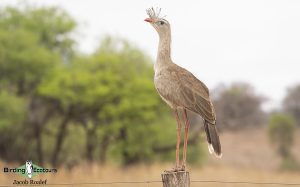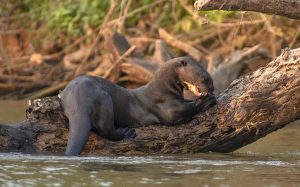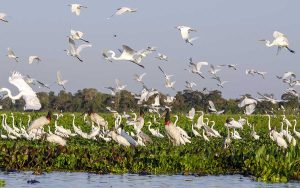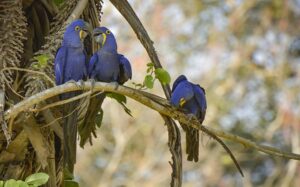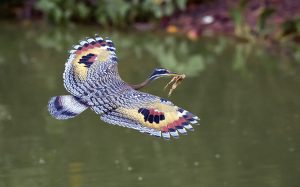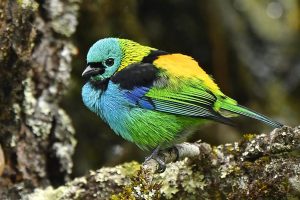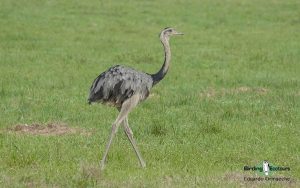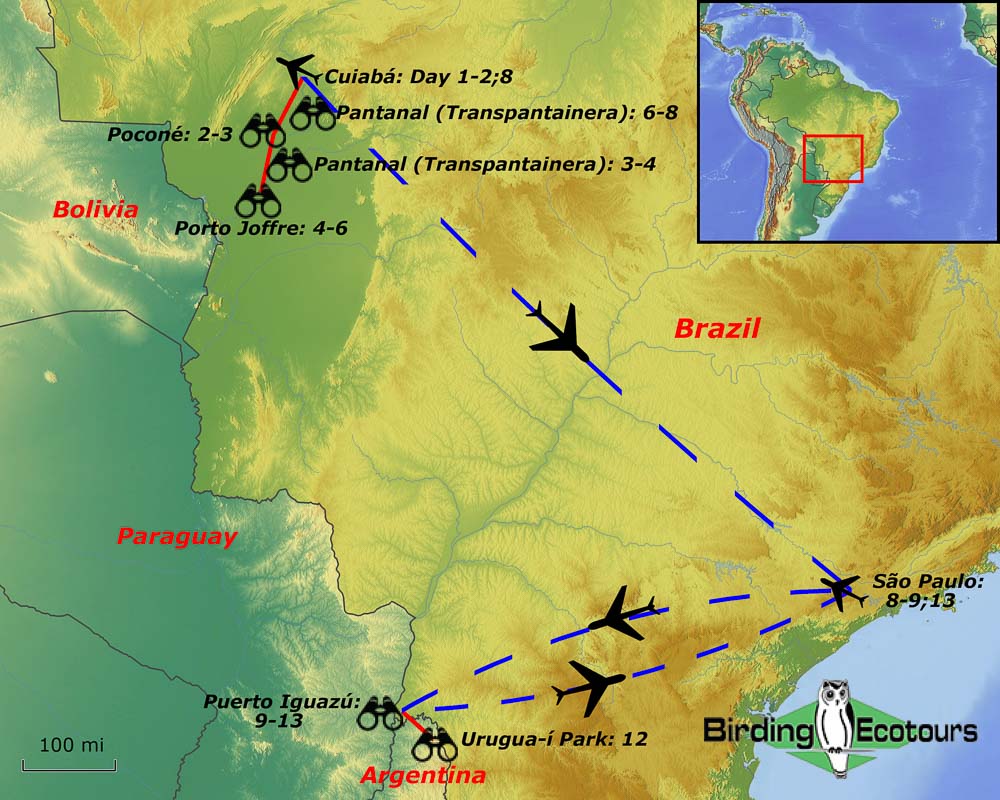Brazil and Argentina: The Pantanal and Iguazu Falls
Brazil and Argentina: The Pantanal and Iguazu Falls
October 2025/2026
This tour will surely rank as one of your neotropical wildlife highlights of your lifetime! Our Brazil and Argentina itinerary will allow you to explore two iconic, fascinating and highly diverse neotropical ecosystems: the Pantanal and the Atlantic Forest, while also including the truly impressive Iguazu Falls. While in the Pantanal we will enjoy an exciting full morning and afternoon boat safari along the Cuiabá River, concentrating on finding the world’s third-largest feline, the elusive and charismatic Jaguar!
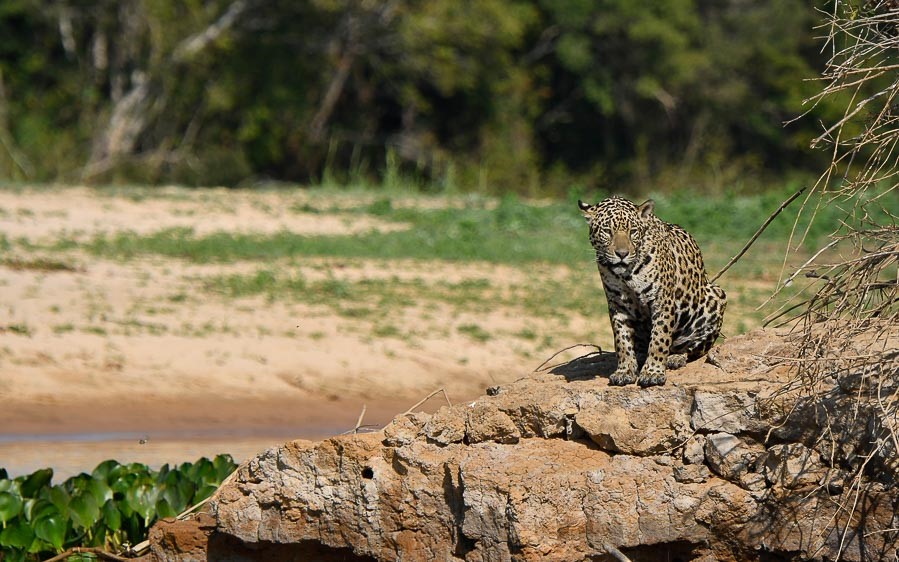
We will begin our birding and mammal adventure by exploring the Pantanal, a vast, seasonally flooded wetland, renowned for its incredible concentrations of birds at the end of the dry season. We schedule this tour during this particular season, when fish trapped in shrinking pools of water attract hordes of herons, egrets, storks, and other wetland species. The star of these huge concentrations is the massive Jabiru, towering over a diverse collection of smaller South American waterbirds, such as Sunbittern, Plumbeous, Bare-faced, Green, and Buff-necked Ibises, Grey-cowled Wood Rail and Southern Screamer. There is normally a large diversity of raptors around too, with Snail Kite, Black-collared, Savanna and Crane Hawks regularly encountered. Our river trips provide the opportunity to look for species such as Capped Heron, Sungrebe, the striking Agami Heron, Anhinga and a plethora of kingfishers including Green, Amazon, Ringed, American Pygmy and Green-and-rufous Kingfishers. Other target species include Band-tailed Antbird and, with some luck, the seldom-seen Zigzag Heron. These boat trips also provide the best chances to see Endangered (IUCN) Giant (River) Otters, the largest otter in the world, and one of the ‘Big Five’ of South American mammals. This is also the best place on the planet for seeing Jaguar — during the dry season sightings are almost guaranteed. This humongous cat shines brightly as the star of the show on this tour.
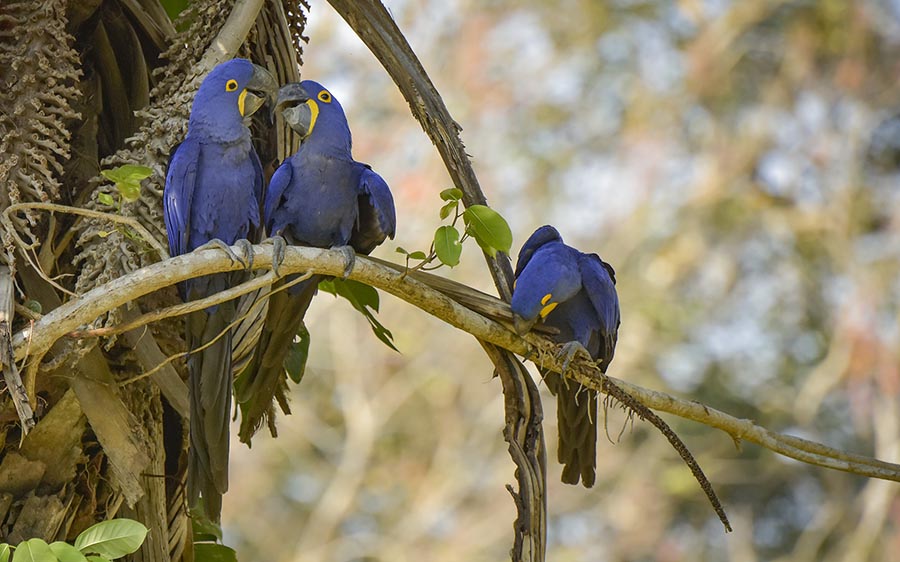
The Pantanal is not only rich in water-associated avifauna; we will also bird its large grasslands, gallery forests, marshes, and plains for species such as Chotoy, Rusty-backed, and White-lored Spinetails, Scarlet-headed Blackbird, Greater Thornbird, Masked Gnatcatcher, Flavescent Warbler, the incredible Helmeted Manakin, White and Pale-crested Woodpeckers and Mato Grosso Antbird.
This region is simply a paradise for parrot-lovers, with standout species including the iconic and threatened Hyacinth Macaw, the largest species of flying parrot in the world, and one of Brazil’s great conservation success stories. Other parrot species likely to be seen in the Pantanal include the likes of Golden-collared Macaw, Blue-crowned, Peach-fronted, White-eyed, Nanday, and Yellow-chevroned Parakeets, Orange-winged and Turquoise-fronted Amazons and Scaly-headed Parrot.
In addition to birds, many mammal species call the Pantanal home. It is perhaps South America’s greatest wildlife refuge, and we should enjoy daily sightings of Capybara (the largest rodent in the world), primates such as Black-tailed Marmoset, Bearded Capuchin and Black-and-gold Howler Monkeys. With luck, we might encounter Marsh Deer, Crab-eating Raccoon, South American Coati, Yellow Armadillo, Lowland (Brazilian) Tapir and Giant Anteater.
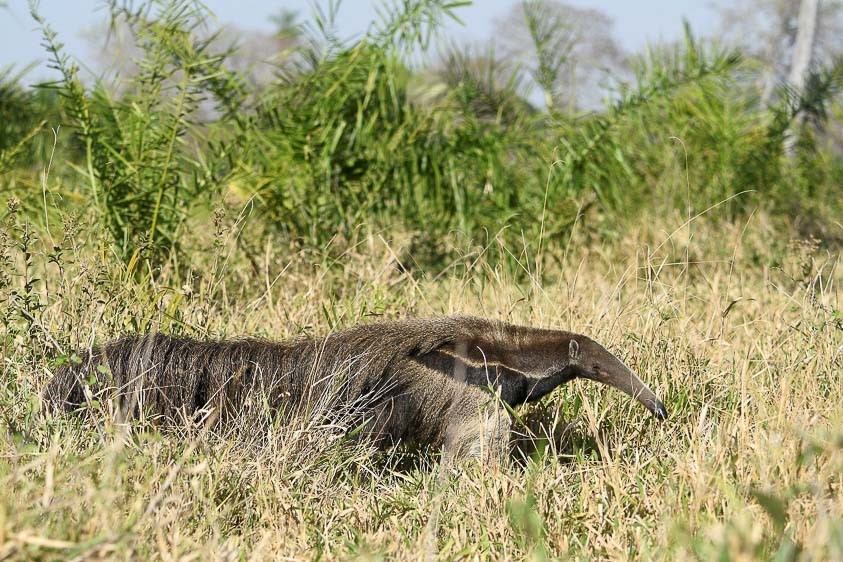
We finish the tour with a few days birding the magnificent Iguazú Falls. Surrounded by Atlantic Forest and bordering Brazil, Argentina, and Paraguay, Iguazú Falls is one of the great natural wonders of the world as the Iguazú River tumbles over the edge of the Parana Plateau. It is often considered the world’s most spectacular waterfall. Ever since the Spaniards discovered these falls in the 16th century, they have not ceased to impress travelers from all over the world, and a visit here can be considered a once-in-a-lifetime trip — certainly one of the wonders of South America. The falls span over 1.6 miles (2.6 kilometers) and are comprised of over 275 distinct falls, forming a breathtaking sight. Perhaps the most impressive is the U-shaped Devil’s Throat which is 250 feet (82 meters) high, 450 feet (150 meters) wide and 2,100 feet (700 meters) long; this is the truly iconic waterfall of the park, immortalized in the iconic 1986 movie The Mission.Even though the waterfalls are shared by Brazil and Argentina, we spend the bulk of the time on the Argentinian side (using a super easy border crossing), which has better birding with better trail facilities.
During this part of the tour, we will have adequate time to admire the waterfalls and look for the area’s special birds. Target species include the impressive Great Dusky Swift, which roost on the waterfall cliffs, Red-rumped Cacique, Toco Toucan, Chestnut-eared Aracari, Blond-crested and Yellow-fronted Woodpeckers, Ochre-collared Piculet, Blue (Swallow-tailed) Manakin, Southern Antpipit, Eared Pygmy Tyrant, Chestnut-bellied Euphonia, Green-headed Tanager, Streak-capped Antwren, Surucua Trogon, Rufous-capped Motmot, Greenish Schiffornis, Rufous Gnateater, Dusky-tailed Antbird, and the most-wanted Black-fronted Piping Guan.
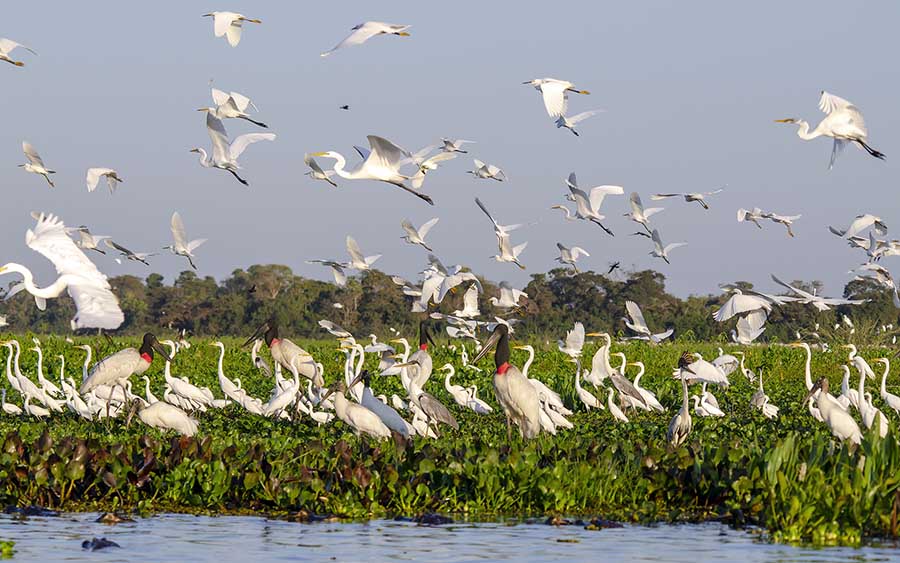
Itinerary (13 days/12 nights)
Day 1. Arrival in Cuiabá and transfer to the hotel
After your arrival at Marechal Rondón International Airport (CGB) in Várzea Grande Cuiabá, you will be met by our staff and transferred to your comfortable hotel near to the airport.
Overnight: Hotel Amazon Aeroporto, Cuiabá
Day 2. Transfer to the Pantanal
We will leave the hotel after breakfast to head towards Poconé, the gateway to the Brazilian Pantanal. Along the drive it is possible to find species such as Greater Rhea, Red-legged Seriema, Crested Caracara, Toco Toucan, Cattle Tyrant, and White-tailed Hawk.
We will arrive at Pouzo Alegre Lodge where we will be greeted by our first Pantanal species such as Southern Screamer, Plumbeous and Buff-necked Ibises, Black-bellied Whistling Duck, Whistling Heron, Guira Cuckoo, Limpkin, Jabiru, Cocoi Heron, Roseate Spoonbill, Crane Hawk, and Brown-chested Martin, among many others. In the evening we will switch to 4×4 vehicles to do our first night safari drive looking for some of the Pantanal’s exciting nocturnal mammals. We will have our first chances for Lowland Tapir (the largest South American mammal), Crab-eating Fox and with luck, Giant Anteater.
Our lodge is more of a rancho hacienda style but is still comfortable and is located away from the road, deep in the woodlands, with night drives offering good chances for mammals. Lowland Tapirs are commonly seen here and with a lot of luck we may see Southern Tamandua, Six-banded Armadillo, Ocelot and even the rare Puma, which is very scarce in the Pantanal and our expectations should be set low. The lodge is great for birding with bird feeders for us to enjoy and some nearby old dry deciduous forest which offers birds such as Planalto Slaty Antshrike and Black-bellied Antwren.
Overnight: Pouzo Alegre Lodge
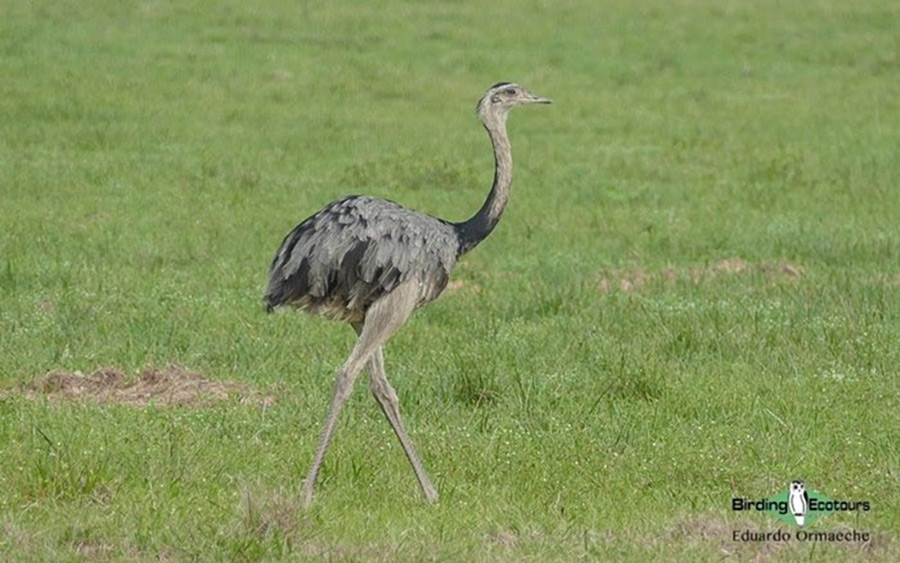
Day 3. Transfer to Hotel Mato Grosso and birding the Transpantainera Road
We will leave the lodge and head to the famous Transpantainera Road where we will likely find species such as Black-collared Hawk, White-headed Marsh Tyrant, Scarlet-headed Blackbird, Yellow-billed Cardinal, Golden-collared Macaw, Monk Parakeet, Amazon, Ringed and Green Kingfishers, and Yellow-chinned Spinetail.
Mato Grosso Hotel is strategically located along the shores of the Sararé River (Pixaim) where we will have our first boat trip hoping to find several species of birds including some classic aquatic species, but our main target is the Zigzag Heron, one of the rarest and poorly-known birds in the neotropics. This area offers you some of the best chances to see this elusive heron. We also have opportunities for Agami Heron, American Pygmy Kingfisher, Anhinga, Band-tailed and Rusty-backed Antbirds, Buff-throated Woodcreeper, and Red-crested Cardinal. We will also have our first chances for Giant (River) Otters. At night we may find Crab-eating Raccoons around the lodge.
Overnight: Hotel Mato Grosso
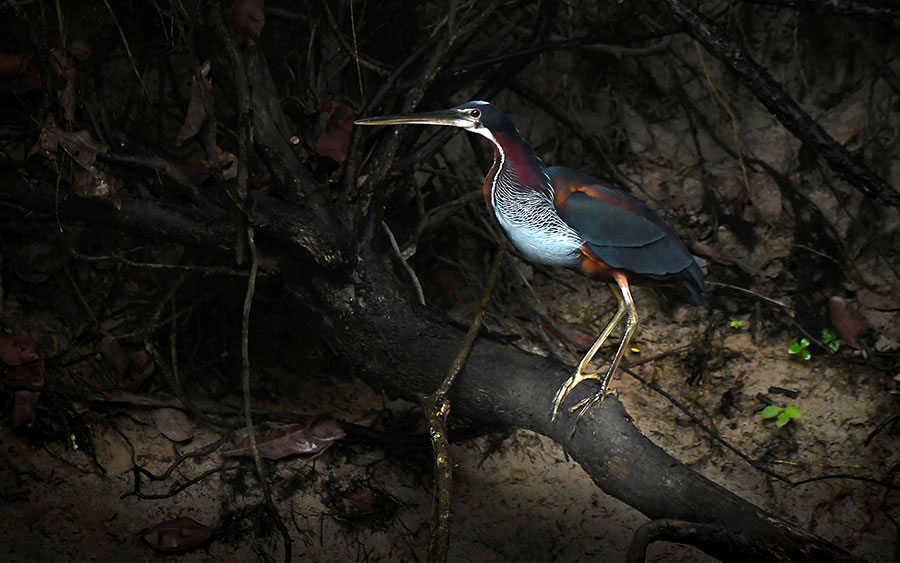
Day 4. Birding Mato Grosso Hotel and transfer to Porto Joffre
Today we will have an early start to explore the nearby grasslands and gallery forest looking for species such as Chestnut-vented Conebill, Great Rufous Woodcreeper, Grey-crested Cachalote, Long-tailed Ground Dove, White-headed Marsh Tyrant, Black-backed Water Tyrant, Mato Grosso Antbird, Purplish Jay, Variable Oriole, Wattled Jacana, Snail Kite, and Marsh Deer. After this, we will leave the lodge and drive along a road passing through several ponds which will likely be full of birds as well Yacare Caimans and Capybaras.
We will arrive at Hotel Pantanal Norte in Porto Joffre and will spend the afternoon birding along the Transpantainera where we will search for species such as Least Bittern, Spotted Rail, Cinereous-breasted Spinetail, Nanday Parakeet, Bare-faced Ibis, Maguari Stork, and with some luck, Undulated Tinamou.
Overnight: Hotel Pantanal Norte
Day 5. Jaguar Safari
Today we will explore the Cuiabá River in the morning looking for Jaguars. This is the best place in the world to see Jaguars and we should have very good chances of seeing this mighty animal. On our boat trip we will explore different sectors of the river in search of Jaguars. We also have our best chances of finding Giant (River) Otters on this day. We will return to the lodge for lunch and after a short break, will head back down to the river for our second boat safari, again focusing our efforts on finding Jaguars. During our boat trip it is possible to see Collared and Pied Plovers, Large-billed, Common and Yellow-billed Terns, Black-bellied Whistling Duck and Paraguayan Howler Monkeys.
Overnight Hotel Pantanal Norte
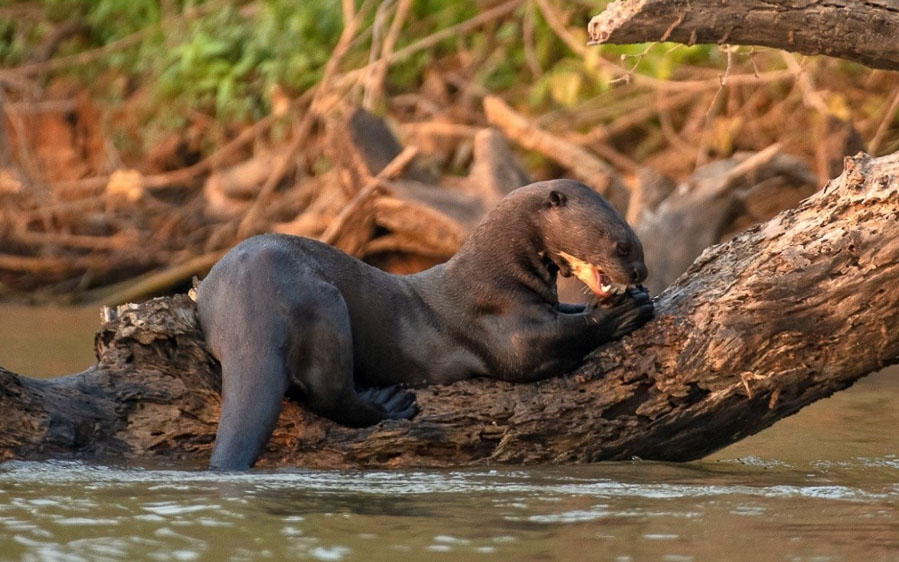
Day 6. Transfer to Piuval Lodge
We will again bird the Transpantainera and spend two nights at Piuval Lodge where we may have time to start looking for some of the targets listed below.
Overnight: Piuval Lodge
Day 7. Piuval Lodge birding
We will spend the full day exploring Pousada Piuval. Our first activity will be a predawn search for Giant Anteater, if we haven’t yet seen it. Later we will explore the expansive areas of this huge property to look for Pale-crested Woodpecker, Greater Thornbird, Chaco Chachalaca, White-throated Piping Guan, Bare-faced Curassow, Picui Ground Dove, Grey-cowled Wood Rail, Sunbittern, Savanna Hawk, Turquoise-fronted Amazon, Red-billed Scythebill, White-lored Spinetail, Orange-backed Troupial, and Greyish Baywing.
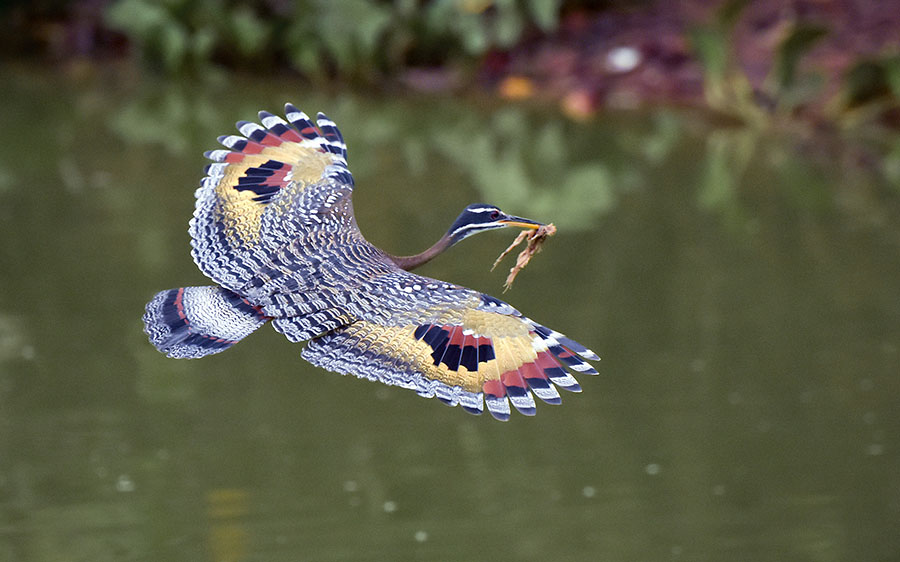
The star of the day is likely to be the Hyacinth Macaw, an icon of the Pantanal and one of the last remaining strongholds for this species. Furthermore, the lodge area offers good chances for Black-fronted Capuchin and Silvery Marmoset.
We will have a break after lunch and spend the rest of the afternoon birding around the lodge. In the evening we will have a second 4×4 safari night drive hoping to encounter more fascinating wildlife.
Overnight: Piuval Lodge
Day 8. Transfer to Cuiabá Airport and flight to Sao Paulo
We will have our last morning birding around the lodge and along Transpantainera before finally heading back to Cuiabá Airport to connect with our flight to Sao Paulo. Upon arrival, we will transfer to our hotel for the evening.
Overnight: Hampton Inn, Sao Paulo
Day 9. Arrival at Foz do Iguazú Airport and transfer to the Argentinean side
This morning we will head back to Sao Paulo Airport and catch a flight to Foz de Iguazú Airport, in the Brazilian state of Parana. From here we will immediately transfer to Puerto Iguazú on the Argentinean side, in the state of Misiones. Crossing the border is relatively easy, usually taking half an hour by car; the two cities are separated by nine miles (15 km).

We will check in to our comfortable hotel, spend the afternoon birding around the accommodation’s grounds, and visit the hummingbird garden, Jardin de Picaflores. Here we hope to see hummers such as Black Jacobin, Black-throated Mango, Glittering-bellied and Versicolored Emeralds, Scale-throated and Planalto Hermits, White-throated and Swallow-tailed Hummingbirds, Violet-capped Woodnymph, and Gilded Sapphire. Other birds we might see today include Ochre-collared Piculet, Chestnut-bellied and Violaceous Euphonia, Green-headed, Ruby-crowned, Sayaca, Black-goggled and Guira Tanagers, Chestnut-eared Aracari, and Plush-crested Jay.
Overnight: Selva del Laurel Lodge
Day 10. Iguazú Falls and Devil’s Throat
Today we will have an early start to get into Iguazú Park and visit the famous Devil’s Throat, probably the most spectacular point of all the waterfalls. We will have time to walk the lower and upper trail circuits within the Argentinean side of the park, allowing you to see the waterfalls from different angles, with abundant photographic opportunities throughout. One of the main bird highlights of the day will be the impressive Great Dusky Swifts flying around and perching on the vertical cliff faces of the waterfalls.
Overnight: Selva Del Laurel Lodge
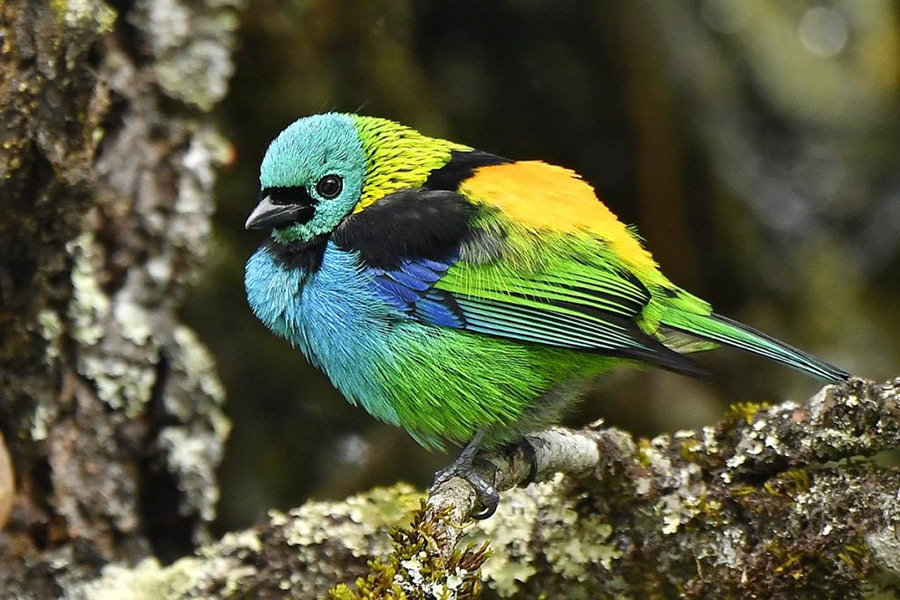
Days 11-12. Exploring Iguazú Park surroundings and Urugua-í Provincial Park
We will spend two full days birding different sectors close by to the Iguazú waterfalls. One site we’ll visit is the Urugua-í Provincial Park, located 63 miles (100 km) from our hotel; here we will look for the Endangered Black-fronted Piping Guan. This bird can be tricky to find in other Atlantic Forest areas but in the southern Misiones state of Argentina, it can be reliably found. Other birds we hope to see include Black-throated Trogon, Rufous-capped Motmot, Green-billed Toucan, and Yellow-fronted, Blond-crested, Lineated and Robust Woodpeckers. Furthermore, we will also look for Black-billed Scythebill, Tufted Antshrike, Rufous-winged Antwren, Short-tailed Antthrush, and several woodcreepers such as White-throated, Olivaceous, Plain-winged and Planalto Woodcreepers.
The list of targets during these two days is long and includes a few skulkers such as White-eyed, Ochre-breasted and Buff-fronted Foliage-gleaners, White-throated Spadebill, Red-crowned Ant Tanager, Eared Pygmy Tyrant, Southern Antpipit, and Plain Antvireo. Other more obvious (and as usual, beautiful) species that we will be on the lookout for include Swallow Tanager, Boat-billed, Social and Three-striped Flycatchers, White-winged Swallow, Pale-breasted and White-necked Thrushes, Riverbank Warbler, Chestnut-vented Conebill, Magpie, Chestnut-headed and White-lined Tanagers, and Blue-naped Chlorophonia.
Overnight: Selva del Laurel Lodge
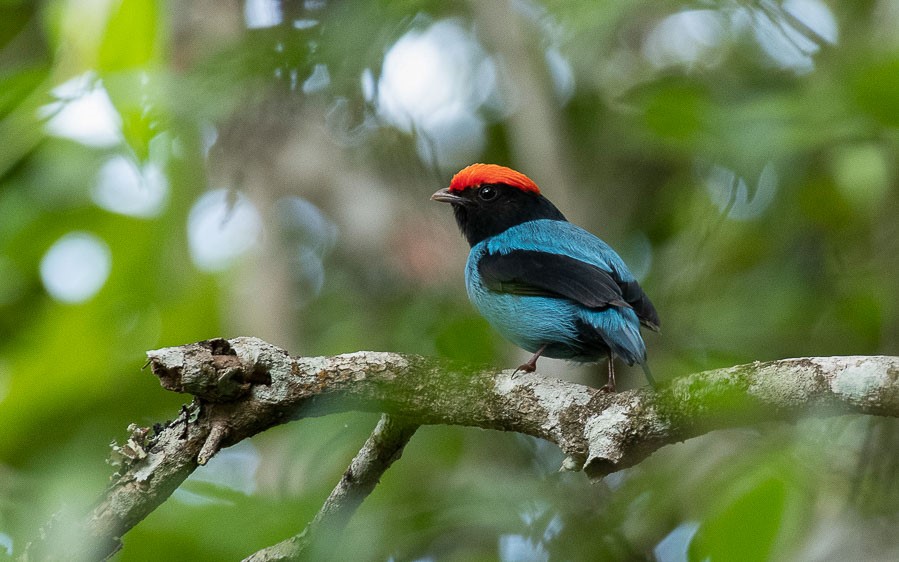
Day 13. Transfer to the Brazilian side, visiting the waterfalls and flight to Sao Paulo
Today we will cross the Brazilian border again and (if time permits) have a short visit to the Brazilian side of the waterfalls, where we can view the falls from different angles and perhaps find some birds we might have missed on previous days. You will then be transferred to the Foz de Iguazu Airport to catch a flight back to Sao Paulo where you will connect with your international flight home.
Please note that the itinerary cannot be guaranteed as it is only a rough guide and can be changed (usually slightly) due to factors such as availability of accommodation, updated information on the state of accommodation, roads, or birding sites, the discretion of the guides. In addition, we sometimes have to use a different guide from the one advertised due to tour scheduling or other reasons.
Download ItineraryBrazil and Argentina: The Pantanal, Cerrado and Iguazú Falls Trip Report, September 2022
DOWNLOAD TRIP REPORT
21 SEPTEMBER – 05 OCTOBER 2022
By Eduardo Ormaeche
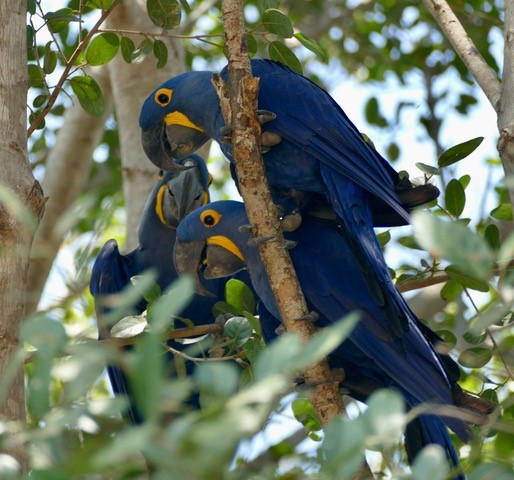
Hyacinth Macaw, an iconic bird of the Pantanal (photo Eric Schroeder).
Overview
In September 2022 I traveled to Brazil to lead a Birding Ecotours tour with the Golden Gate Bird Alliance. After a two-year absence due to the pandemic, I was more excited than ever to return to one of my favorite destinations in the Neotropics! This trip was designed to give participants the opportunity to explore three important and iconic ecosystems in Brazil: Firstly, the Pantanal, the largest seasonal wetland in the world, home to a vast number of birds and wildlife, and famous for its Jaguar-viewing opportunities. Secondly, the Cerrado, a unique habitat of deciduous scrub and tropical savanna, which is unfortunately threatened due to deforestation and fires. Finally, the Atlantic Forest, a vast and diverse forest that extends across much of Brazil and within which the mighty Iguazú Falls, on the Brazil-Argentina border, is found.
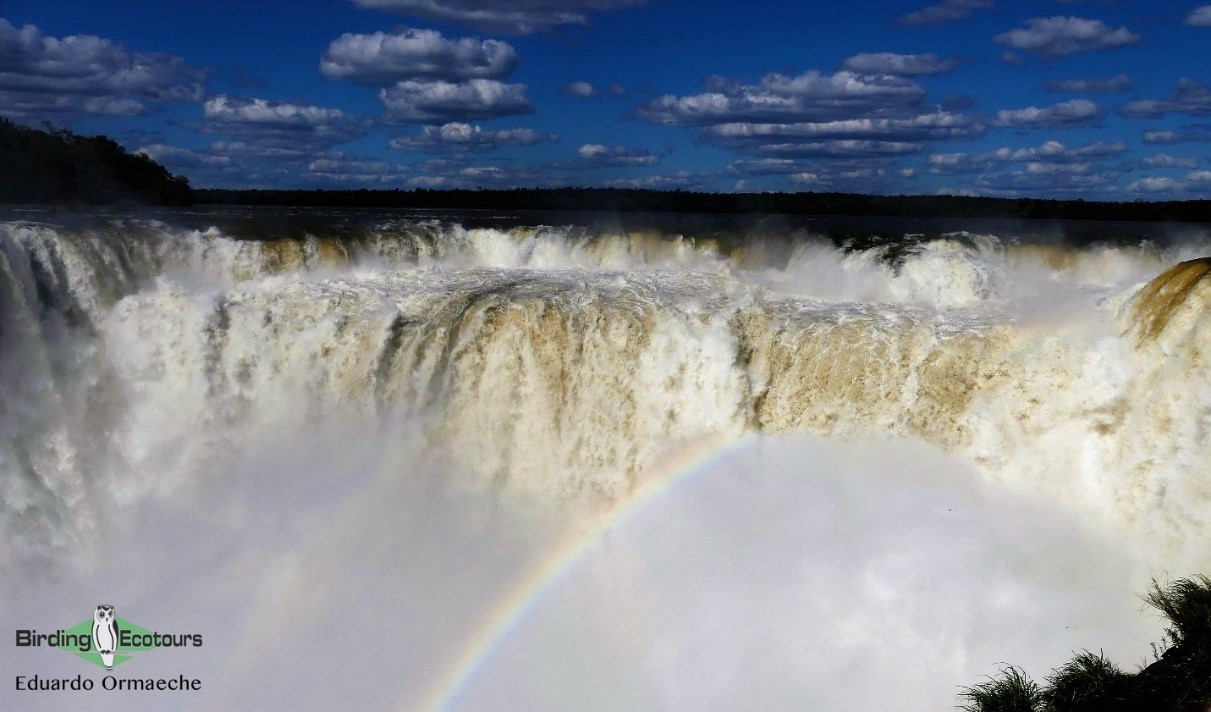
The Devil’s Throat of Iguazú Falls from Argentina.
During this fantastic two-week birding tour, we recorded numerous fantastic species including Hyacinth Macaw, Sungrebe, Sunbittern, Greater Rhea, Jabiru, Roseate Spoonbill, Agami Heron, Zigzag Heron, Helmeted Manakin, Red-ruffed Fruitcrow, Green-headed Tanager, Black Jacobin, Great Dusky Swift, Sharp-tailed Streamcreeper, Red-billed Scythebill, Rufous-capped Motmot, Surucua, Black-throated and Blue-crowned Trogons, Araucaria Tit-Spinetail, White-eyed Foliage-gleaner, Black-fronted Piping Guan, Great Rufous Woodcreeper, Blond-crested Woodpecker, Common and Great Potoos, Toco Toucan, White-rumped and Fulvous Shrike-Tanagers, and many others. In addition to our birding encounters, we had a variety of mammals, including four of Brazil’s ‘Big Five’: Jaguar, Giant Anteater, Lowland Tapir and Giant (River) Otter.This was a superb trip for birders, wildlife enthusiasts and adventurous travelers alike.
Detailed Report
Day 1, 21st September 2022. Arrival in São Paulo, and transfer to Argentina
The group met at the Guarulhos International Airport in São Paulo, before connecting with a domestic flight to Foz do Iguazú in the Brazilian state of Paraná. In Foz de Iguazú, we were welcomed by Pocho, our excellent Argentinean local guide who would be with us while in Iguazú. We arrived at the Argentina-Brazil border, which is easy to navigate for international travelers visiting the Urugua-í Park and its stunning waterfalls. This was the first time many of our group members had traveled to Brazil, Iguazú or the Pantanal, which added to the excitement of the adventure that awaited us.
We then traveled to our accommodation where we would stay for the next four nights, the Selva de Laurel Lodge, which is conveniently located near ‘600 Hectares’, a famous birding hotspot in the Argentinean state of Misiones. The crisscrossing of borders meant that we could immediately start adding birds to both our Brazilian and Argentinian country lists. We birded along the roads and around the immigration offices which produced Squirrel Cuckoo, Southern Lapwing, Picazuro Pigeon, Plumbeous Kite, White Woodpecker, Yellow-chevroned Parakeet, Crested Caracara, Turquoise-fronted Amazon, Sayaca Tanager, Saffron Finch, Grey-breasted Martin, and Rufous Hornero. These were the first birds we could officially add to our Argentinian bird list. After an exciting first day, we returned to our accommodation and prepared for the following day.
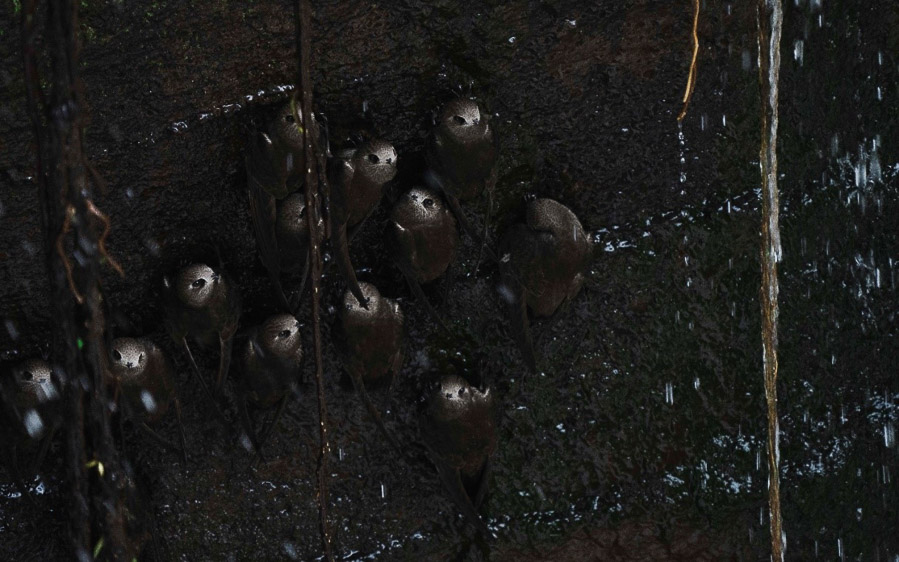
Great Dusky Swifts at Iguazú Falls (photo Carl Wang).
Day 2, 22nd September 2022. Birding the Iguazú Falls and Jardin de los Picaflores
The next day we started birding around the lodge before leaving for Iguazú National Park which opens at 8 a.m. We heard Rufous-capped Motmot calling before dawn, but they were rather distant. We then saw Yellow-fronted Woodpecker, Chestnut-eared Aracari, Planalto Woodcreeper, Eared Pygmy Tyrant, Fuscous Flycatcher, Chestnut-bellied Euphonia, Plush-crested Jay, Golden-crowned Warbler, Swallow Tanager, and Red-rumped Cacique. We heard Ochre-collared Piculet, which unfortunately did not show for us, however the stunning Blond-crested Woodpecker was seen by everyone.
After a few hours of birding around the lodge we left for Iguazú National Park. We arrived at the park, and after dealing with the long lines and crowds, we made our way to the spectacular Devil’s Throat, which at a height of 269 feet (82 meters), is the largest waterfall of the Iguazú Falls. From the cliffs, we were able to get amazing scope views of Great Dusky Swifts roosting, as well as flying above the mighty waterfalls.
Along the boardwalks and above the waterfalls, we enjoyed sightings of Snail Kite, Neotropic Cormorant, Chestnut-vented Conebill, Saffron Finch, Red-rumped Cacique, and Scaly-headed Parrot. We also had some interesting wildlife encounters, with great views of South American Coati, Black-capped Capuchin, Iguazu Lava Lizard, Black Tegu and Granulated Catfish.
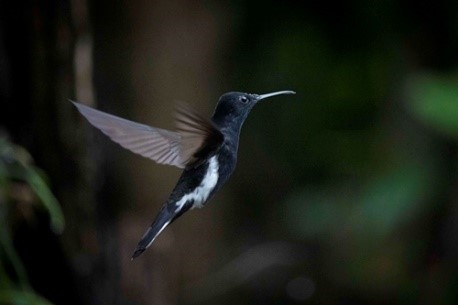
Black Jacobin, an Atlantic Forest hummingbird special (photo Carl Wang).
The rain arrived at midday, and by now we were ready for a meal at the restaurant in Iguazú National Park, which turned out to be one of the best meals of the trip. We then headed to the Jardin de los Picaflores, a hummingbird garden in Puerto Iguazú. Here, we enjoyed our first sightings of these beautiful and unique avian jewels, and seeing as this was the only hummingbird feeding station we would visit on the trip, we appreciated our time here even more. We had a wonderful time at the bird feeders, enjoying views of Black Jacobin, Black-throated Mango, Glittering-bellied and Versicolored Emeralds, Violet-capped Woodnymph, White-throated and Swallow-tailed Hummingbirds, Gilded Sapphire, Planalto and Scale-throated Hermits, as well as Violaceous Euphonia and Variable Oriole. After a great day at the Iguazú Falls, we returned to the lodge to get some well-deserved rest, in preparation for the next day.
Day 3, 23rd September 2022. Exploring the Brazilian side of Iguazú Falls
Today we left Puerto Iguazú and crossed the border to visit the Brazilian side of Iguazú Falls. Before we even got out of the bus, we spotted a Black-fronted Piping Guan, an Endangered Atlantic Forest endemic, which everyone was able to see. Shortly afterwards, we saw our first Toco Toucan, as well as the beautiful Green-headed Tanager. Seeing Black-fronted Piping Guan, one of the trip highlights, on the Brazilian side of the Iguazú Falls was an amazing start. Although the Argentinian side of the Iguazú Falls is better in terms of walking trails and convenient birding sites, the Brazilian side produced some unexpected surprises, and gave us even more spectacular views of the waterfall.
Before it started raining and was covered in mist, participants took the opportunity to photograph the waterfall. I felt sorry for those who arrived later and missed this photographic opportunity, but in terms of our birding successes, we were very content.
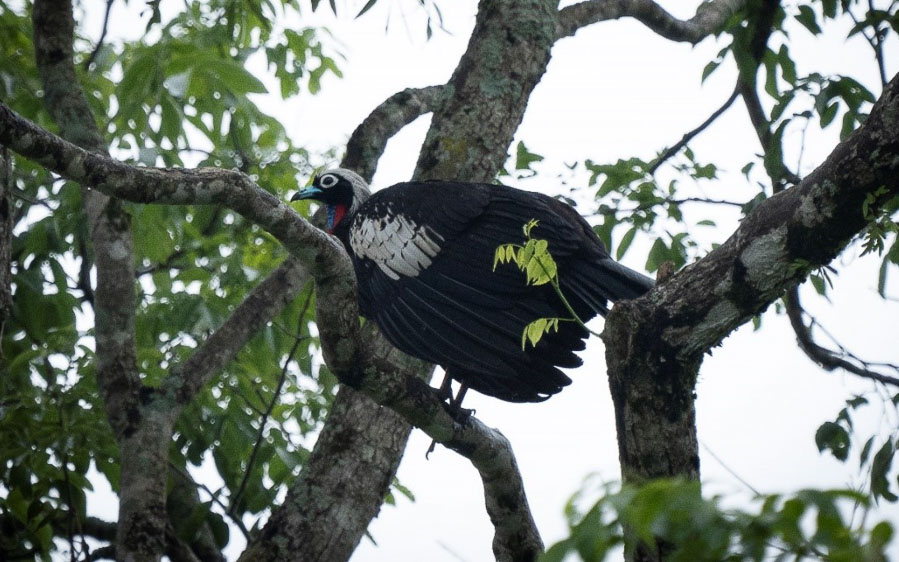
The Endangered Black-fronted Piping Guan, one of the highlights of Iguazú (photo Carl Wang).
In the evening, we went outside the lodge to try for Black-capped Screech Owl, which we heard, but unfortunately never saw. Although we tried hard for this bird, the bad weather and elusive nature of this individual meant that our efforts went unrewarded. This was a pity, but we returned to the lodge looking forward to the next day at the Urugua-í Park.
Day 4, 24th September 2022. Exploring Urugua-í Park
Urugua-í Park, named after local conservationist, Dr. Luis Honorio Rolon, protects habitat around the source of the Uruguaí River, which originates in the highlands of the Misiones Province. At 2,470 acres (84,000 hectares), this is perhaps one of the best places to see Black-fronted Piping Guan, as well as many other species. The birding started off slowly, with a few species showing well, including Green-backed Becard, and we had a great sighting of Chestnut-crowned Becard building a nest right next to the parking lot. We then had a Campo Flicker, and our first flock of Maroon-bellied Parakeet.Other species seen included the widespread Great Kiskadee, Streaked and Piratic Flycatchers, Red-rumped Caciques and Swallow Tanager. Despite it being quiet in the humid and misty Atlantic Forest, we soon found a Red-ruffed Fruitcrow.
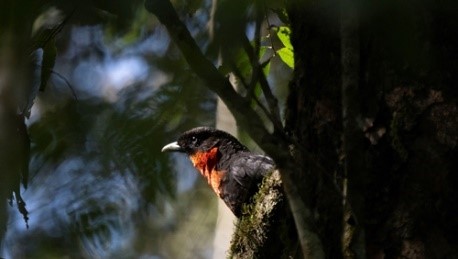
Red-ruffed Fruitcrow in the Urugua-í Park (photo Carl Wang).
In the forest interior we found Surucua Trogon, Southern Beardless and Greenish Tyrannulets, Sepia-capped Flycatcher, Southern Bristle Tyrant, White-necked Thrush, Golden-crowned Warbler, Tropical Parula, Red-crowned Ant Tanager, Ruby-crowned Tanager, Green-winged Saltator, and Riverbank Warbler, and with some local knowledge and good luck, we saw White-eyed Foliage-gleaner, a bird that does not always show well.
We left the forest and tried for a another sought-after Furnarid from this part of the world, the secretive Sharp-tailed Streamcreeper – a bird which is found in the Atlantic Forest, in the humid mountains of the Andes. We looked along the main road, and were lucky enough to be able to feast our eyes on this small and mysterious stream skulker. We heard a Black-fronted Piping Guan in the distance, but were unable to see it, so I was especially pleased that we had seen one on the previous day on the Brazilian side of Iguazú Falls. We saw Scaly-headed Parrots of the race melanoblepharus, distinguishable from the race maximiliani (which we later saw in the Pantanal) by the absence of a white eye ring.
After a great picnic lunch, where Pocho provided a variety of ‘Argentinean empanadas’ to keep our spirits up, we left Urugua-í Park and investigated an Araucaria woodland where we got great views of another special, Araucaria Tit-Spinetail,and we heard a Blacksmith Thrush which only a few participants had seen at Urugua-í Park.
We decided to have dinner outside of our accommodation seeing that Puerto Iguazú has many restaurant options, which Pocho helped us to choose from. After a great day of birding, we returned to the lodge to get ready for our last day in Iguazú.
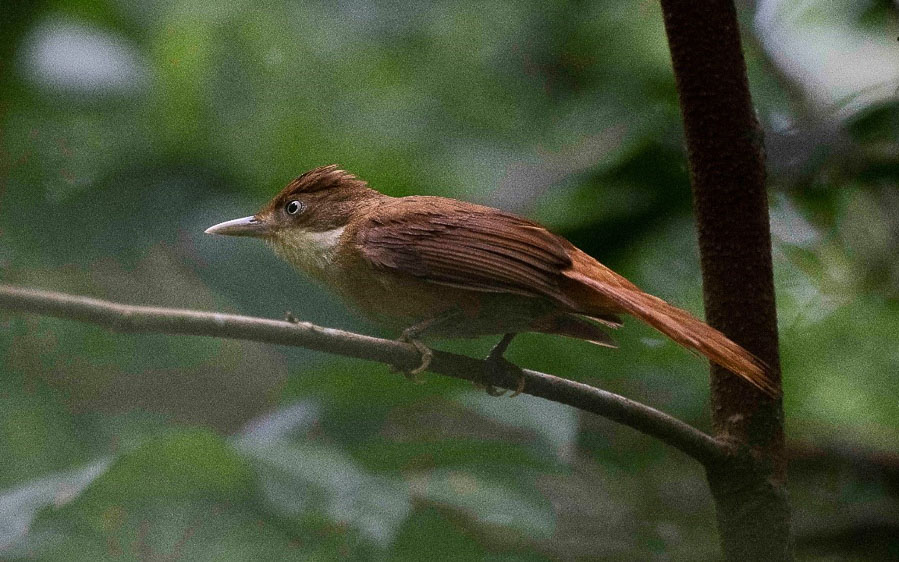
The secretive White-eyed Foliage-gleaner at the Urugua-í Park (photo Carl Wang).
Day 5, 25th September 2022. Morning flight to São Paulo, with a connecting flight to Cuiabá
Today we returned to the Foz do Iguazú Airport in Brazil. We said goodbye to our Argentinian team and prepared for a long day of travel. Before we left Iguazú, on the way to the airport, we managed to see a pair of Burrowing Owls, which made several people very happy, especially Carl who had never seen one before. The first flight was from Foz do Iguazú to São Paulo, which was then followed by a connecting flight to Cuiabá, our rendezvous for the Pantanal and Cerrado trip. We arrived at Cuiabá and were transferred to our accommodation at Hotel Slaviero. Despite the heat and humidity, we were very excited about the prospect of exploring the Pantanal and the Cerrado over the next few days.
Day 6, 26th September 2022. Transfer to Chapada dos Guimarães, with birding en route
We left Cuiabá and birded en route as we headed towards Chapada dos Guimarães National Park and were immediately impressed with the red cliffs and mountains of this new landscape. Our first stop was near an impressive cliff known as ‘Hell’s Gate’, and along the way we encountered some interesting scrub species including Red-and-green Macaw, White-tailed Hawk, Ferruginous Pygmy Owl, Toco Toucan, Cliff (with more grey than white on the head, compared to the Andean tropical foothills population) and Boat-billed Flycatchers Burnished-buff and White-lined Tanagers, Chalk-browed Mockingbird, as well as one of the specials here, Blue-winged Macaw.
After having lunch in town, we moved to Pousada do Parque, our base for the next three nights, which was conveniently located on the outskirts of the Chapada do Guimarães National Park. Here, we had Guira Cuckoo, Southern Lapwing, Chopi Blackbird, Red Pileated Finch, and we saw a Planalto Hermit feeding in the flowers around the reception and pool.
We spent the rest of the afternoon birding around the scenic lodge grounds. Other species which showed well during the afternoon included Scaled Pigeon, Ruddy Ground and White-tipped Doves, Smooth-billed Ani, White-vented Violetear and Glittering-bellied Emerald, Amazonian Motmot, Swallow-winged Puffbird, Lettered Aracari, Yellow-tufted, Little, Lineated and Green-barred Woodpeckers, Creamy-bellied Thrush, Double-collared Seedeater, Black-faced Tanager, Small-billed Elaenia, and Masked Tityra. We also had Rufous Hornero, the Argentinean national bird, and Rufous-bellied Thrush, the Brazilian national bird.
Day 7, 27th September 2022. Chapada dos Guimarães National Park and Pousada do Parque
We spent the first hours of the morning birding along the main track on the way to the entrance of the Chapada dos Guimarães National Park. Along this road we found some interesting and widespread species such as Blue Dacnis, Amazonian Motmot, White Woodpecker, Narrow-billed Woodcreeper, Rufous Casiornis, Rufous Hornero, Helmeted Manakin (female), Short-crested Flycatcher, Masked Tityra, Sayaca Tanager, Flavescent Warbler, Red Pileated Finch, and Black-throated Saltator.
Although there is extensive Cerrado habitat outside of the park, we were able to find some of our target species in more accessible areas, such as Água Fria and the Geladeira Road, as well as the road that takes you to Stone City, where it is possible to see the Endangered Yellow-faced Amazon. Unfortunately, the road is not always in good condition, and it sometimes requires a 4×4 vehicle, depending on the time of year one is traveling.
We spent some time at the famous Bride’s Veil Waterfall, which is created by several streams that run down the slopes of the plateaus (Planalto in Portuguese) and discharge into the Cuiabá River and the Pantanal. Here, we managed to see flocks of White-eyed Parakeet, Red-and-green Macaw, Cliff Flycatcher, Blue-winged Macaw, and Cindi spotted a Great Dusky Swift roosting, which was great to see. We tried forCrested Black Tyrant, but unfortunately did not see one today.
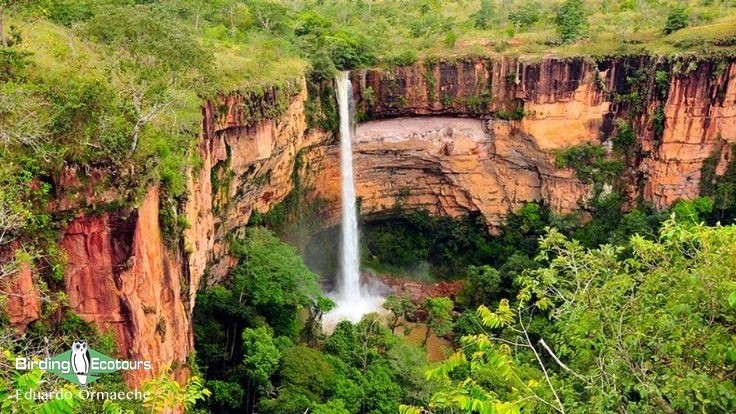
Bride’s Veil in Chapada dos Guimarães.
We then visited Vale de Benção, one of the few remaining pockets of forest in the Cerrado, where it is possible to find interior forest species, and to find shade as the heat intensifies. As soon as we arrived, we had Amazonian Motmot, Black-fronted Nunbird, Rufous-tailed Jacamar, Lettered Aracari, Red-shouldered Macaw, Yellow-tufted Woodpecker, Swallow-tailed Hummingbird, Large-billed Antwren, Crested Oropendola, Variable Oriole, Buff-throated Saltator, Pale-breasted Thrush, and for the second time on this trip, we saw Sharp-tailed Streamcreeper.
Later that afternoon we explored the open areas of the Cerrado, finding birds such as Red-legged Seriema, which gave us a great performance as it crossed the road. Other bird sightings included Chapada Flycatcher, Rusty-backed Antwren, Large Elaenia, Plumbeous Seedeater, Black-throated Saltator and Peach-fronted Parakeet. Red-winged Tinamou was heard,but we were unfortunately unable to see it on this occasion. We then returned to the Pousada do Parque Lodge to relax and enjoy the beautiful surroundings.
Day 8, 28th September 2022. Chapada dos Guimarães and Pousada do Parque
Today we left very early in the morning to explore the open areas of the Cerrado. Close to the Estrada Água Fria, we found some interesting Cerrado specials such as Black-faced and Shrike-like Tanagers, and we saw White-rumped Tanagers doing a territorial display. We added several of the usual suspects, including great views of White-eared Puffbird and Campo Flicker.However, Collared Crescentchest proved elusive this year. After a morning of birding the Cerrado, we moved back to the lodge before a rainstorm descended upon us, with such strong winds that some tables and chairs blew off the ground. Some people went inside to get some rest, while others stayed outside to see the few birds that could endure the storm, which produced Chopi Blackbird and Purplish Jay. The rain continued for most of the afternoon, but eventually stopped and allowed us to continue birding around the lodge.
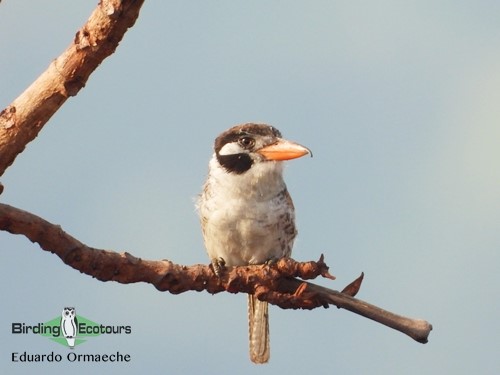
White-eared Puffbird at Chapada dos Guimarães.
We had productive birding within the lodge grounds, with Yellow-tufted, Lineated and Green-barred Woodpeckers Black-crowned Tityra, Barred Antshrike, White-lined Tanager all seen in the vicinity. We were also fortunate to see a Narrow-billed Woodcreeper building a nest which was interesting to watch. Beautiful Red-and-green Macaws are always a pleasure to see flying above the Cerrado and are a sign of hope in the face of the many threats this special habitat faces. Perhaps the most exciting sighting was the secretive Red-winged Tinamou,which was seen well by everyone as itwalked shyly above the grass along the fence-line.
Just before dusk we got to see Nacunda Nighthawk, as well as alarge number of bats emerging from a building that they had been nesting in. During our stay in Pousada do Parque, we did not see any Brazilian Cavy, and the small family group living in the lodge grounds was nowhere to be seen, possibly having been predated on by Crab-eating Foxes which are widespread in the Pantanal and Cerrado. The other culprit could have been the similar-looking Hoary Fox,a seldom-seen Brazilian endemic, which inhabits the Cerrado and can be tricky to tell apart at night, especially with brief views.
Day 9, 29th September 2022. Transfer to the Pantanal (Pouso Alegre), and birding en route
The next morning, those who were up early enough saw a male Scissor-tailed Nightjar near the pool. We then left the lodge and were transferred to the Geodesic stakeout, where we added another Red-winged Tinamou, Black-chested Buzzard-Eagle, White-collared Swift, Grey Monjita,as well as the other usual suspects, but we didn’t see any Crested Black Tyrants. Sadly, it was time to leave Chapadados Guimarães, and we headed back to Cuiabá to begin exploring the Pantanal.
Staying at Pousada do Parque is a highly recommended and worthwhile stopover, as it is located within the national park itself. This means that birds and wildlife are easy to find, and we also had easier access to nocturnal birds on our night drives. After some time birding at Iguazú and the Atlantic Forest, our time in the Cerrado was equally productive, with clients birding in the early mornings, enjoying a rest during the heat of the day, before more birding later in the day.
On the way back to Cuiabá, we stopped at a municipal park where we saw a few species we had already seen, but we were especially pleased when a Helmeted Manakin (male) showed well for us, which is very lucky, as the bird often only shows when play-back is used. We took our time to enjoy this bird, and then headed back to the restaurant at Cuiabá for a tasty lunch. After our lunch, we headed to Poconé with high expectations, and our first stop on the way was at a marshland, where we had a great number of aquatic species such as White-faced Whistling Duck, Brazilian Teal, Rufescent Tiger Heron, Wattled Jacana, Black-necked Stilt, Little Blue and Striated Herons, Yellow-chevroned Parakeets and Brown-chested Martin, amongst others.
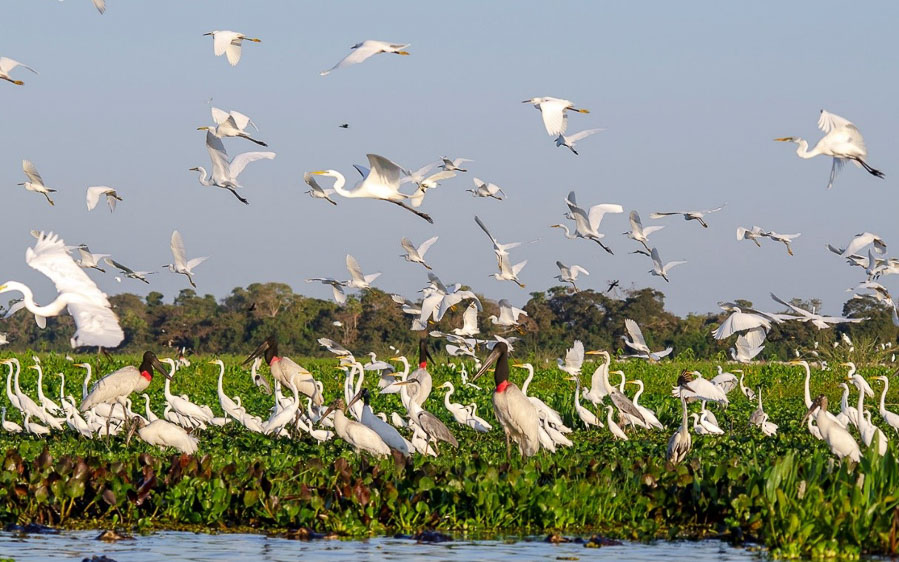
A variety of aquatic species in the Pantanal (photo Ricardo Boschetti).
We then continued our journey to Piuval Lodge, our base from which we would explore the Pantanal. After a quick check-in, we had time to bird in the lodge vicinity, as well as in the seasonally flooded grasslands where we had Jabiru, Wood Stork, Cocoi Heron, Black Skimmer, Great, Snowy and Western Cattle Egrets, Bare-faced and Plumbeous Ibises, and Roseate Spoonbill. We were fortunate to spot a Crane Hawk, one of the less abundant open-country raptors in the Pantanal, and everyone had brilliant scope views of this individual. This was followed by Campo Flicker, White-eyed Parakeet, Rufous Cachalote, Red-crested Cardinal, and Fork-tailed Flycatcher. The Pantanal is also famous for having the world’s largest population of Capybara, and it was here that we had our first sighting of this large rodent.
After dinner we went on an open-vehicle 4×4 drive, finding our first Marsh Deer, as well as a few pairs of Crab-eating Foxes. In addition, we saw several Little Nightjars and Pauraques, giving participants the chance to see the differences between the two species, without having to rely on the call differences to separate them.
Day 10, 30th September 2022. Birding around the lodge, and transfer to Hotel Mato Grosso
Before dawn, we were out exploring the lodge surroundings when one of the ‘Big Five’ of Brazil, and one of the most desirable species of South America, the Giant Anteater was spotted. We were fortunate enough to have amazing views of this remarkable creature, which is still found in South American grasslands, savanna, and the Amazon Rainforest.
Then, without needing to return to the lodge at 730 a.m. for breakfast (which is customary at Pantanal and Cerrado lodges), we were able to take advantage of having the additional time to bird around the lodge at this productive time of day. We had a great time birding inside the lodge grounds in the open-vehicle 4x4s, affording us great views of birds we had seen regularly. We also had Sunbittern, Grey-cowled Wood Rail, Chaco Chachalaca, White-throated Piping Guan [White-throated Piping Guan (Pipile grayi) is a recent split from Blue-throated Piping Guan (P. cumanensis) based on differences in plumage, the shape and color of the wattle, and limited hybridization in contact zones in southeastern Peru], and Bare-faced Curassow. The Pantanal contains a healthy population of Bare-faced Curassows, making them particularly easy to see here compared to other parts of the New Word.
The moment we had all been waiting for on the tour finally arrived when the highly desirable Hyacinth Macaw, which is considered the largest parrot species, was seen flying above the beautiful Pantanal landscape, followed by an even closer view of a pair at the top of a tree. Everyone had great scope views of this obliging pair, and this was when Eric took the photo that appears on the cover of this trip report. Although other lodges have Hyacinth Macaws roosting in their gardens, the experience of seeing a pair attending a natural nest is simply magical and watching this species flying over the Pantanal woodlands is the best way to see these magnificent birds.
We continued birding for the rest of the morning, finding great species such as Pale-crested Woodpecker and Little Woodpeckers, Campo Flicker, Toco Toucan, Ferruginous Pygmy Owl, White-lored Spinetail, Southern Scrub Flycatcher, Rufous Casiornis, Cattle Tyrant, Streaked Flycatcher, Masked Gnatcatcher, White-browed Blackbird, Orange-backed Troupial, Yellow-billed Cardinal, Chestnut-vented Conebill, Pale-breasted and Rufous-bellied Thrushes, Black-fronted Nunbird, and Great Black and Savanna Hawks. The bird that elicited the most excitement from the group must have been the impressive Red-billed Scythebill, which seemed to be playing a game of hide-an-seek at first, but then gave us fantastic views. We then had a Great Potoo roosting at its daytime roost, followed by White-vented Plumeleteer, Fork-tailed Woodnymph, White-vented Violetear, Picui Ground Dove, Turquoise-fronted Amazon, Red-legged Seriema and our first Monk Parakeet. Later that morning, we retreated to the lodge, but not before we had a glimpse of a family of Azara’s Capuchins.
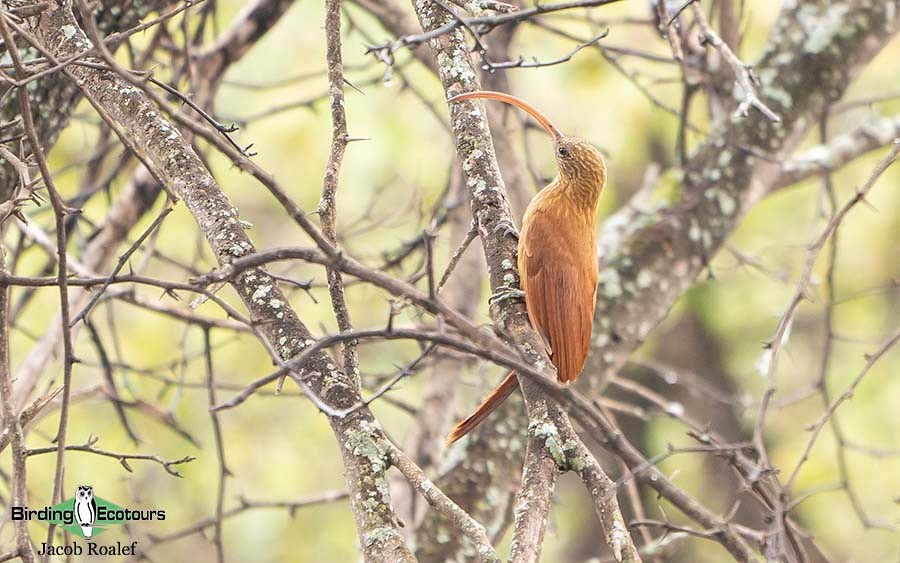
Red-billed Scythebill, a great find in the Pantanal.
After we checked out and had our lunch, we headed along the famous Transpantaneira Road, which is a 90-mile (145 kilometer) dirt road connecting Poconé to Puerto Joffre and contains over 120 bridges. This road crosses the northern Pantanal and is a paradise for birds and wildlife, as well as hosting several lodges, restaurants, and recreational activities along the way. Many of these lodges were once cattle ranches (fazendas in Portuguese) which have now been repurposed for ecotourism.
While driving along the Transpantaneira Road, we saw plenty of aquatic species, including a few new species for the trip including Maguari Stork, Capped Heron, Black-collared Hawk, Lesser Yellow-headed Vulture, Ringed and Green Kingfishers, Yellow-chinned Spinetail, White-headed Marsh Tyrant, Black-backed Water Tyrant, Rufescent Tiger Heron, Spotted Sandpiper, as well as Jabiru at a nest.
As soon as we entered the Pantanal, we had a better understanding of the type of species that are typical of this habitat, starting with a large gathering of Yacare Caiman around the last-remaining lagoons and wetlands of the dry season. Yacare Caiman are now considered common in the Pantanal, and are classified as a species of Least Concern, but from 1970 to 1996 they were classed as ‘Endangered’ due the illicit trade of their skins. Today, Yacare Caiman are one of the main dietary sources of Jaguars, and as such are a critical part of the Pantanal’s ecosystem.
We arrived at Pouso Alegre where we found the endemic Chestnut-bellied Guan, Greater Rhea, Hyacinth Macaw, Bare-faced Curassow, Amazon Kingfisher, and Chaco Chachalaca. It was very hot when we arrived at the lodge, so we decided to rest and bird around the lodge grounds before we went on the open-vehicle 4×4 drive. Along the drive we saw Great Horned Owl, Common Potoo, Little Nightjar, Common Pauraque, and a roosting Toco Toucan. No new mammals were seen, but the lodge grounds provided good views of Crab-eating Foxes, and once we got back to the lodge itself, we had Lowland Tapir, anindividual which had become habituated, and would often sneak into the lodge vicinity to look for food.
Day 11, 1st October 2022. Birding around the lodge, and transfer to Mato Grosso Lodge
Today we took an early walk around the lodge, and in the woodland and scrub habitat we found White-lored Spinetail, Caatinga Cacholote, Narrow-billed Woodcreeper, Swainson’s Flycatcher, Flavescent Warbler, Thrush-like Wren, Ferruginous Pygmy Owl, Turquoise-fronted Amazon, Scaled Dove, Bare-faced Curassow, Blue-crowned Trogon, Greater Rhea, Chaco Chachalaca, Chestnut-bellied Guan, South American Coati and had further great views of Hyacinth Macaws flying over. We also had perhaps one of our best sightings of Great Rufous Woodcreeper,which was new for the trip.
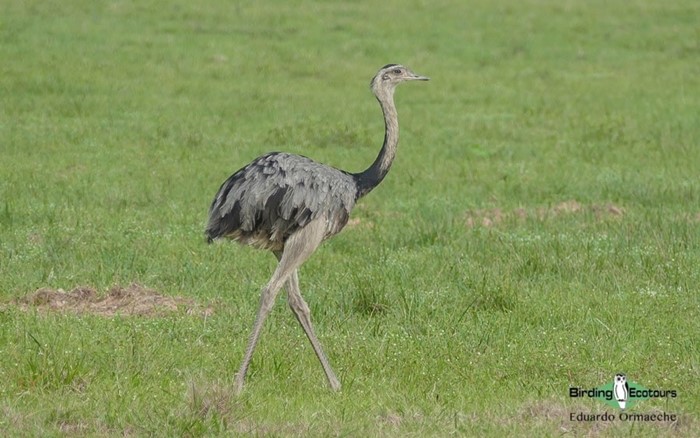
Greater Rhea is found in the Cerrado and grasslands of the Pantanal.
After some productive birding, we headed to Mato Grosso Lodge, located next to the Pixaim River which provided access to a variety of habitats, including woodlands and gallery forest. In the afternoon we embarked on our much-anticipated boat ride, which allowed us to explore the Pixaim River. We saw widespread species such as Anhinga, Neotropic Cormorant, Cocoi Heron, Jabiru, Wood Stork, Green Ibis, Rufescent Tiger Heron, Black-collared Hawk, Boat-billed Heron at a daytime roosting spot, and although American Pygmy Kingfisher took some time to find, we eventually had great views of this cute, little bird. We also had Band-tailed Antbird skulking in the low vegetation, as well as Chestnut-eared Aracari, Pale-legged Hornero, Lesser Kiskadee, Rusty-backed Spinetail and Pale-vented Pigeon. We got very excited when we had our first Sungrebe, which was not easy to find at first, but we all eventually had superb views.
Lowland Tapir, the largest mammal in South America, gave us a great performance when it approached the shore and submerged itself in the water to cross the river. It was amazing to follow the trace of air bubbles as it made its crossing, before its head eventually emerged. By sunset we witnessed flocks of Band-tailed Nighthawks above the water, and we tried for the very secretive and seldom-seen Zigzag Heron, which although difficult to find elsewhere, is relatively easy in the Pantanal. It was great to be able to give all participants views of this most-wanted species.
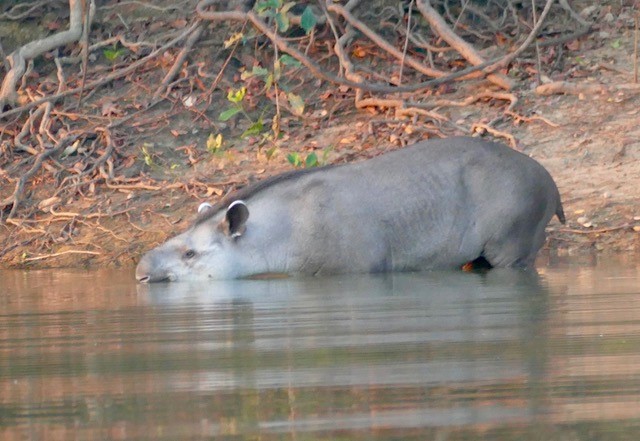
Lowland Tapir gave us a great performance (photo Eric Schroeder).
Day 12, 2nd October 2022. Birding Mato Grosso Lodge, and transfer to Porto Joffre
We spent the early morning birding the lodge grounds, including the adjacent marsh and the gallery forest, enabling us to add several new birds to the trip list. The old airstrip is always a good place to start, and we had good views of Nanday Parakeets flying over. We then had excellent sightings of Chotoy Spinetail, Peach-fronted Parakeet, and Scaly-headed Parrot, of the Pantanal race siy, which shows white orbital skin, in comparison to the Atlantic Forest race which we saw around Iguazú. We then had White-bellied Seedeater, Buff-bellied Hermit, Bluish-grey Saltator, and Variable Oriole, followed by a handsome Marsh Deer watching us from the grasslands.
Once on the trail, we continued birding which produced Mato Grosso Antbird, Ashy-headed Greenlet, Flavescent Warbler, Blue-crowned Trogon, Buff-throated Woodcreeper, Rufous-tailed Jacamar, Pale-crested Woodpecker, Black-fronted Nunbird, Pearly-vented and Stripe-necked Tody-Tyrants and Yellow-olive Flatbill.A final visit to the marsh near to the lodge allowed us to find Long-tailed Ground Dove,which took some effort, but we all eventually managed to see it. We left Mato Grosso Lodge and continued along the Transpantaneira Road on the way to Porto Joffre, stopping at a few strategic places on the way, allowing us to find species such as Scarlet-headed Blackbird, Rusty-collared Seedeater, Black-capped Donacobius, Large-billed Tern, Black Skimmer, Southern Screamer, and Unicolored Blackbird.
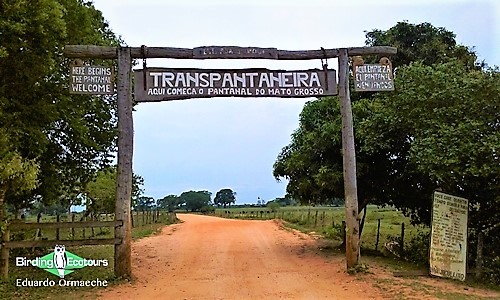
The start of the Transpantaneira Road.
We arrived at the Hotel Pantanal Norte in Porto Joffre where we checked in and had a tasty lunch. After a short respite, we met at the lodge’s jetty to begin our journey by speed boat along the Cuiabá River where we hoped to find the highly prized Jaguar. This river flows to the Paraguay River, and then into La Plata in Argentina, eventually ending up in the Atlantic Ocean. The rivers of the Pantanal contain the largest concentration of Jaguars in the world, and the high numbers of Capybara and Yacare Caiman in the Pantanal provide the Jaguar population with a reliable food source. Jaguar sightings are therefore relatively easy, especially during the region’s dry months when the riverbanks are exposed. We were lucky to have our first encounter with Jaguars on the first afternoon on the riverbank, when an individual emerged from the bush, allowing us to have magnificent views. We also had encounters with birds such as Collared and Pied Plovers, Black-bellied Whistling Duck, and Large-billed Tern.
Day 13, 3rd October 2022. Jaguar viewing by boat and birding around Porto Joffre
We had another full morning to explore the Cuiabá River and to look for more Jaguar. We were extremely fortunate to see an adult female with two almost fully mature cubs, which was a very special wildlife encounter. We then had an awesome encounter with another most-wanted mammal in the Pantanal, the charismatic Giant (River) Otter, resulting in outstanding views of a family which demonstrated the species’ full repertoire of social and fishing behaviors. We then returned to the lodge to have lunch and to take a break, before heading out into the field for the afternoon.

We had wonderful Jaguar views in the Pantanal (photos Eric Schroeder).
In the afternoon, we explored the surrounding area of the Transpantaneira, where we found Solitary Cacique, Barred Antshrike and Striped Cuckoo.We tried hard for Grey-breasted Crake, which came close, but did not show.We also worked hard for Cinereous-breasted Spinetail,which took some time to find, but was eventually seen by everyone. The day ended on a high note when we saw Undulated Tinamou, which Freya spotted through the thick bush, while it was calling and sitting motionless. Everyone was delighted to have scope views of this elusive bird that we had heard so often in the Cerrado and Pantanal, but due to its shy-nature had not been seen until now.
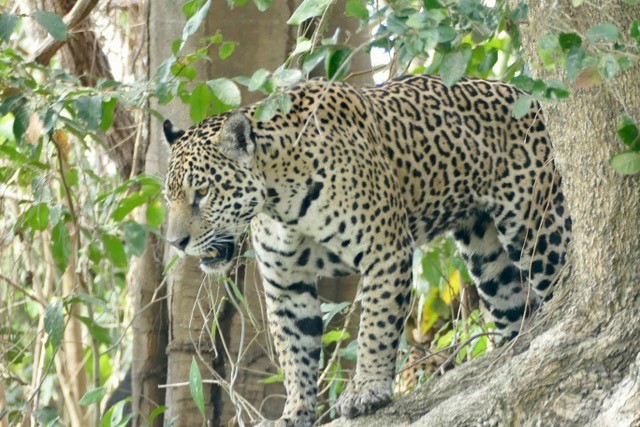
We had wonderful Jaguar views in the Pantanal (photos Eric Schroeder).
Day 14, 4th October 2022. Birding the Transpantaneira Road, and transfer to Cuiabá
Today was our last day in the Pantanal, which was essentially a transfer day back to the city. We had planned a couple of strategic stops, including a lunch-stop. Although we were not expecting anything new, we enjoyed a few final photo opportunities of the Pantanal along with many of the wonderful birds we had seen previously on the trip. Perhaps the best surprise was when we spotted a young Yellow Anaconda disappearing from the road into the bushes, providing us with a glimpse of most of the snake. We finally reached Poconé and saw about three Blue-and-yellow Macaws, as well as a few more regularly seen species. We finally arrived at the hotel, and had supper at our favorite restaurant in town where we celebrated the end of a truly fantastic two-week birding trip of Brazil and Argentina.
Day 15, 5th October 2022. Departure from São Paulo
On our final day, participants were transferred to the Cuiabá Marechal Rondon International Airport to catch their connecting flights back to São Paulo where they eventually departed, bringing the tour to its conclusion.

Giant (River) Otters in the Pantanal (photo Ricardo Boschetti).
Bird List – Following IOC (13.1)
Birds ‘heard only’ are marked with (H) after the common name, all other species were seen.
The following notation after species names is used to show conservation status following BirdLife International: VU = Vulnerable.
| Common Name | Scientific Name |
| Rheas (Rheidae) | |
| Greater Rhea | Rhea americana |
| Tinamous (Tinamidae) | |
| Undulated Tinamou | Crypturellus undulatus |
| Small-billed Tinamou | Crypturellus parvirostris |
| Red-winged Tinamou | Rhynchotus rufescens |
| Screamers (Anhimidae) | |
| Horned Screamer | Anhima cornuta |
| Southern Screamer | Chauna torquata |
| Ducks, Geese, Swans (Anatidae) | |
| White-faced Whistling Duck | Dendrocygna viduata |
| Black-bellied Whistling Duck | Dendrocygna autumnalis |
| Muscovy Duck | Cairina moschata |
| Brazilian Teal | Amazonetta brasiliensis |
| Chachalacas, Curassows, Guans (Cracidae) | |
| Chaco Chachalaca | Ortalis canicollis |
| Chestnut-bellied Guan (Endemic) – VU | Penelope ochrogaster |
| White-throated Piping Guan | Pipile grayi |
| Black-fronted Piping Guan – EN | Pipile jacutinga |
| Bare-faced Curassow – VU | Crax fasciolata |
| Nightjars (Caprimulgidae) | |
| Nacunda Nighthawk | Chordeiles nacunda |
| Band-tailed Nighthawk | Nyctiprogne leucopyga |
| Pauraque | Nyctidromus albicollis |
| Little Nightjar | Setopagis parvula |
| Potoos (Nyctibiidae) | |
| Great Potoo | Nyctibius grandis |
| Common Potoo | Nyctibius griseus |
| Swifts (Apodidae) | |
| Great Dusky Swift | Cypseloides senex |
| White-collared Swift | Streptoprocne zonaris |
| Sick’s Swift | Chaetura meridionalis |
| Grey-rumped Swift | Chaetura cinereiventris |
| Hummingbirds (Trochilidae) | |
| Black Jacobin | Florisuga fusca |
| Scaly-throated Hermit | Phaethornis eurynome |
| Buff-bellied Hermit | Phaethornis subochraceus |
| Planalto Hermit | Phaethornis pretrei |
| Black-throated Mango | Anthracothorax nigricollis |
| White-vented Violetear | Colibri serrirostris |
| Blue-tufted Starthroat | Heliomaster furcifer |
| Glittering-bellied Emerald | Chlorostilbon lucidus |
| Fork-tailed Woodnymph | Thalurania furcata |
| Violet-capped Woodnymph | Thalurania glaucopis |
| Swallow-tailed Hummingbird | Eupetomena macroura |
| Sapphire-spangled Emerald | Chionomesa lactea |
| Versicolored Emerald | Chrysuronia versicolor |
| White-throated Hummingbird | Leucochloris albicollis |
| Glittering-throated Emerald | Chionomesa fimbriata |
| Gilded Sapphire | Hylocharis chrysura |
| Cuckoos (Cuculidae) | |
| Guira Cuckoo | Guira guira |
| Greater Ani | Crotophaga major |
| Smooth-billed Ani | Crotophaga ani |
| Striped Cuckoo | Tapera naevia |
| Squirrel Cuckoo | Piaya cayana |
| Pigeons, Doves (Columbidae) | |
| Rock Dove (Introduced) | Columba livia |
| Scaled Pigeon | Patagioenas speciosa |
| Picazuro Pigeon | Patagioenas picazuro |
| Scaled Dove | Columbina squammata |
| Ruddy Ground Dove | Columbina talpacoti |
| Picui Ground Dove | Columbina picui |
| Blue Ground Dove | Claravis pretiosa |
| Long-tailed Ground Dove | Uropelia campestris |
| White-tipped Dove | Leptotila verreauxi |
| Eared Dove | Zenaida auriculata |
| Finfoots (Heliornithidae) | |
| Sungrebe | Heliornis fulica |
| Rails, Crakes & Coots (Rallidae) | |
| Grey-cowled Wood Rail | Aramides cajaneus |
| Grey-breasted Crake (H) | Laterallus exilis |
| Limpkin (Aramidae) | |
| Limpkin | Aramus guarauna |
| Stilts, Avocets (Recurvirostridae) | |
| Black-necked Stilt | Himantopus mexicanus |
| Plovers (Charadriidae) | |
| Southern Lapwing | Vanellus chilensis |
| Collared Plover | Charadrius collaris |
| Pied Plover | Hoploxypterus cayanus |
| Jacanas (Jacanidae) | |
| Wattled Jacana | Jacana jacana |
| Sandpipers, Snipes (Scolopacidae) | |
| Spotted Sandpiper | Actitis macularius |
| Solitary Sandpiper | Tringa solitaria |
| Lesser Yellowlegs | Tringa flavipes |
| Greater Yellowlegs | Tringa melanoleuca |
| Gulls, Terns, Skimmers (Laridae) | |
| Black Skimmer | Rynchops niger |
| Large-billed Tern | Phaetusa simplex |
| Sunbittern (Eurypygidae) | |
| Sunbittern | Eurypyga helias |
| Storks (Ciconiidae) | |
| Wood Stork | Mycteria americana |
| Maguari Stork | Ciconia maguari |
| Jabiru | Jabiru mycteria |
| Anhingas, Darters (Anhingidae) | |
| Anhinga | Anhinga anhinga |
| Cormorants, Shags (Phalacrocoracidae) | |
| Neotropic Cormorant | Nannopterum brasilianum |
| Ibises, Spoonbills (Threskiornithidae) | |
| Plumbeous Ibis | Theristicus caerulescens |
| Buff-necked Ibis | Theristicus caudatus |
| Green Ibis | Mesembrinibis cayennensis |
| Bare-faced Ibis | Phimosus infuscatus |
| Roseate Spoonbill | Platalea ajaja |
| Herons, Bitterns (Ardeidae) | |
| Rufescent Tiger Heron | Tigrisoma lineatum |
| Agami Heron – VU | Agamia agami |
| Boat-billed Heron | Cochlearius cochlearius |
| Zigzag Heron | Zebrilus undulatus |
| Black-crowned Night Heron | Nycticorax nycticorax |
| Striated Heron | Butorides striata |
| Western Cattle Egret | Bubulcus ibis |
| Cocoi Heron | Ardea cocoi |
| Great Egret | Ardea alba |
| Capped Heron | Pilherodius pileatus |
| Whistling Heron | Syrigma sibilatrix |
| Little Blue Heron | Egretta caerulea |
| Snowy Egret | Egretta thula |
| New World Vultures (Cathartidae) | |
| King Vulture | Sarcoramphus papa |
| Black Vulture | Coragyps atratus |
| Turkey Vulture | Cathartes aura |
| Lesser Yellow-headed Vulture | Cathartes burrovianus |
| Ospreys (Pandionidae) | |
| Western Osprey | Pandion haliaetus |
| Kites, Hawks, Eagles (Accipitridae) | |
| Swallow-tailed Kite | Elanoides forficatus |
| Plumbeous Kite | Ictinia plumbea |
| Black-collared Hawk | Busarellus nigricollis |
| Snail Kite | Rostrhamus sociabilis |
| Crane Hawk | Geranospiza caerulescens |
| Savanna Hawk | Buteogallus meridionalis |
| Great Black Hawk | Buteogallus urubitinga |
| Roadside Hawk | Rupornis magnirostris |
| White-tailed Hawk | Geranoaetus albicaudatus |
| White Hawk | Pseudastur albicollis |
| Grey-lined Hawk | Buteo nitidus |
| Broad-winged Hawk | Buteo platypterus |
| Owls (Strigidae) | |
| Burrowing Owl | Athene cunicularia |
| Ferruginous Pygmy Owl | Glaucidium brasilianum |
| Great Horned Owl | Bubo virginianus |
| Tropical Screech Owl | Megascops choliba |
| Black-capped Screech Owl (H) | Megascops atricapilla |
| Trogons (Trogonidae) | |
| Blue-crowned Trogon | Trogon curucui |
| Surucua Trogon | Trogon surrucura |
| Black-throated Trogon | Trogon rufus |
| Kingfishers (Alcedinidae) | |
| Amazon Kingfisher | Chloroceryle amazona |
| American Pygmy Kingfisher | Chloroceryle aenea |
| Green Kingfisher | Chloroceryle americana |
| Green-and-rufous Kingfisher | Chloroceryle inda |
| Ringed Kingfisher | Megaceryle torquata |
| Motmots (Momotidae) | |
| Amazonian Motmot | Momotus momota |
| Rufous-capped Motmot | Baryphthengus ruficapillus |
| Jacamars (Galbulidae) | |
| Rufous-tailed Jacamar | Galbula ruficauda |
| Puffbirds (Bucconidae) | |
| White-eared Puffbird | Nystalus chacuru |
| Black-fronted Nunbird | Monasa nigrifrons |
| Swallow-winged Puffbird | Chelidoptera tenebrosa |
| Toucans (Ramphastidae) | |
| Lettered Aracari | Pteroglossus inscriptus |
| Chestnut-eared Aracari | Pteroglossus castanotis |
| Channel-billed Toucan – VU | Ramphastos vitellinus |
| Toco Toucan | Ramphastos toco |
| Woodpeckers (Picidae) | |
| Ochre-collared Piculet (H) | |
| White-wedged Piculet | Picumnus albosquamatus |
| White Woodpecker | Melanerpes candidus |
| Yellow-tufted Woodpecker | Melanerpes cruentatus |
| Yellow-fronted Woodpecker | Melanerpes flavifrons |
| Little Woodpecker | Veniliornis passerinus |
| Green-barred Woodpecker | Colaptes melanochloros |
| Campo Flicker | Colaptes campestris |
| Pale-crested Woodpecker | Celeus lugubris |
| Blond-crested Woodpecker | Celeus flavescens |
| Lineated Woodpecker | Dryocopus lineatus |
| Seriemas (Cariamidae) | |
| Red-legged Seriema | Cariama cristata |
| Caracaras, Falcons (Falconidae) | |
| Crested Caracara | Caracara plancus |
| Yellow-headed Caracara | Milvago chimachima |
| Laughing Falcon | Herpetotheres cachinnans |
| American Kestrel | Falco sparverius |
| Bat Falcon | Falco rufigularis |
| African & New World Parrots (Psittacidae) | |
| Monk Parakeet | Myiopsitta monachus |
| Yellow-chevroned Parakeet | Brotogeris chiriri |
| Cobalt-rumped Parrotlet | Forpus xanthopterygius |
| Scaly-headed Parrot | Pionus maximiliani |
| Blue-headed Parrot | Pionus menstruus |
| Turquoise-fronted Amazon | Amazona aestiva |
| Orange-winged Amazon | Amazona amazonica |
| Maroon-bellied Parakeet | Pyrrhura frontalis |
| Maroon-tailed Parakeet | Pyrrhura melanura |
| Hyacinth Macaw – VU | Anodorhynchus hyacinthinus |
| Peach-fronted Parakeet | Eupsittula aurea |
| Nanday Parakeet | Aratinga nenday |
| Golden-collared Macaw | Primolius auricollis |
| Blue-winged Macaw | Primolius maracana |
| Blue-and-yellow Macaw | Ara ararauna |
| Red-and-green Macaw | Ara chloropterus |
| Red-shouldered Macaw | Diopsittaca nobilis |
| White-eyed Parakeet | Psittacara leucophthalmus |
| Ovenbirds (Furnariidae) | |
| Olivaceous Woodcreeper | Sittasomus griseicapillus |
| Plain-winged Woodcreeper | Dendrocincla turdina |
| Wedge-billed Woodcreeper | Glyphorynchus spirurus |
| Planalto Woodcreeper | Dendrocolaptes platyrostris |
| White-throated Woodcreeper | Xiphocolaptes albicollis |
| Great Rufous Woodcreeper | Xiphocolaptes major |
| Buff-throated Woodcreeper | Xiphorhynchus guttatus |
| Red-billed Scythebill | Campylorhamphus trochilirostris |
| Narrow-billed Woodcreeper | Lepidocolaptes angustirostris |
| Plain Xenops | Xenops minutus |
| Streaked Xenops | Xenops rutilans |
| Pale-legged Hornero | Furnarius leucopus |
| Rufous Hornero | Furnarius rufus |
| Sharp-tailed Streamcreeper | Lochmias nematura |
| Black-capped Foliage-gleaner | Philydor atricapillus |
| White-browed Foliage-gleaner | Anabacerthia amaurotis |
| Ochre-breasted Foliage-gleaner | Anabacerthia lichtensteini |
| White-eyed Foliage-gleaner | Automolus leucophthalmus |
| Araucaria Tit-Spinetail | Leptasthenura setaria |
| Rufous-fronted Thornbird | Phacellodomus rufifrons |
| Greater Thornbird | Phacellodomus ruber |
| Rusty-backed Spinetail | Cranioleuca vulpina |
| Grey-crested Cacholote | Pseudoseisura unirufa |
| Yellow-chinned Spinetail | Certhiaxis cinnamomeus |
| Chotoy Spinetail | Schoeniophylax phryganophilus |
| White-lored Spinetail | Synallaxis albilora |
| Cinereous-breasted Spinetail | Synallaxis hypospodia |
| Antbirds (Thamnophilidae) | |
| Streak-capped Antwren | Terenura maculata |
| Rusty-backed Antwren | Formicivora rufa |
| Large-billed Antwren | Herpsilochmus longirostris |
| Plain Antvireo | Dysithamnus mentalis |
| Barred Antshrike | Thamnophilus doliatus |
| Spot-backed Antshrike (H) | Hypoedaleus guttatus |
| Mato Grosso Antbird | Cercomacra melanaria |
| Band-tailed Antbird | Hypocnemoides maculicauda |
| Antthrushes (Formicariidae) | |
| Short-tailed Antthrush (H) | Chamaeza campanisona |
| Tyrant Flycatchers, Calyptura (Tyrannidae) | |
| Greenish Elaenia | Myiopagis viridicata |
| Large Elaenia | Elaenia spectabilis |
| Plain-crested Elaenia | Elaenia cristata |
| Lesser Elaenia | Elaenia chiriquensis |
| Southern Beardless Tyrannulet | Camptostoma obsoletum |
| Mouse-colored Tyrannulet | Phaeomyias murina |
| Southern Antpipit | Corythopis delalandi |
| Southern Bristle Tyrant | Pogonotriccus eximius |
| Sepia-capped Flycatcher | Leptopogon amaurocephalus |
| Chapada Flycatcher | Guyramemua affine |
| Southern Scrub Flycatcher | Sublegatus modestus |
| Bran-colored Flycatcher | Myiophobus fasciatus |
| Stripe-necked Tody-Tyrant | Hemitriccus striaticollis |
| Pearly-vented Tody-Tyrant | Hemitriccus margaritaceiventer |
| Eared Pygmy Tyrant | Myiornis auricularis |
| Common Tody-Flycatcher | Todirostrum cinereum |
| Yellow-olive Flatbill | Tolmomyias sulphurescens |
| Cliff Flycatcher | Hirundinea ferruginea |
| Fuscous Flycatcher | Cnemotriccus fuscatus |
| Vermilion Flycatcher | Pyrocephalus obscurus |
| Grey Monjita | Nengetus cinereus |
| Black-backed Water Tyrant | Fluvicola albiventer |
| White-headed Marsh Tyrant | Arundinicola leucocephala |
| Long-tailed Tyrant | Colonia colonus |
| Cattle Tyrant | Machetornis rixosa |
| Piratic Flycatcher | Legatus leucophaius |
| Rusty-margined Flycatcher | Myiozetetes cayanensis |
| Social Flycatcher | Myiozetetes similis |
| Great Kiskadee | Pitangus sulphuratus |
| Lesser Kiskadee | Philohydor lictor |
| Streaked Flycatcher | Myiodynastes maculatus |
| Boat-billed Flycatcher | Megarynchus pitangua |
| Variegated Flycatcher | Empidonomus varius |
| Tropical Kingbird | Tyrannus melancholicus |
| Fork-tailed Flycatcher | Tyrannus savana |
| Rufous Casiornis | Casiornis rufus |
| Swainson’s Flycatcher | Myiarchus swainsoni |
| Short-crested Flycatcher | |
| White-eyed Attila | Attila bolivianus |
| Bright-rumped Attila | Attila spadiceus |
| Cotingas (Cotingidae) | |
| Red-ruffed Fruitcrow | Pyroderus scutatus |
| Manakins (Pipridae) | |
| Helmeted Manakin | Antilophia galeata |
| Band-tailed Manakin | Pipra fasciicauda |
| Tityras, Becards, Sharpbill (Tityridae) | |
| Black-crowned Tityra | Tityra inquisitor |
| Black-tailed Tityra | Tityra cayana |
| Masked Tityra | Tityra semifasciata |
| Green-backed Becard | Pachyramphus viridis |
| Chestnut-crowned Becard | Pachyramphus castaneus |
| Vireos, Greenlets, Shrike-babblers (Vireonidae) | |
| Ashy-headed Greenlet | Hylophilus pectoralis |
| Chivi Vireo | Vireo chivi |
| Crows, Jays (Corvidae) | |
| Purplish Jay | Cyanocorax cyanomelas |
| Plush-crested Jay | Cyanocorax chrysops |
| Swallows, Martins (Hirundinidae) | |
| White-winged Swallow | Tachycineta albiventer |
| Blue-and-white Swallow | Pygochelidon cyanoleuca |
| Southern Rough-winged Swallow | Stelgidopteryx ruficollis |
| Brown-chested Martin | Progne tapera |
| Grey-breasted Martin | Progne chalybea |
| Black-capped Donacobius (Donacobiidae) | |
| Black-capped Donacobius | Donacobius atricapilla |
| Wrens (Troglodytidae) | |
| Thrush-like Wren | Campylorhynchus turdinus |
| Fawn-breasted Wren | Cantorchilus guarayanus |
| House Wren | Troglodytes aedon |
| Gnatcatchers (Polioptilidae) | |
| Masked Gnatcatcher | Polioptila dumicola |
| Mockingbirds, Thrashers (Mimidae) | |
| Chalk-browed Mockingbird | Mimus saturninus |
| Thrushes (Turdidae) | |
| Blacksmith Thrush | Turdus subalaris |
| Creamy-bellied Thrush | Turdus amaurochalinus |
| White-necked Thrush | Turdus albicollis |
| Pale-breasted Thrush | Turdus leucomelas |
| Rufous-bellied Thrush | Turdus rufiventris |
| Old World Sparrows, Snowfinches (Passeridae) | |
| House Sparrow (Introduced) | Passer domesticus |
| Finches, Euphonias (Fringillidae) | |
| Purple-throated Euphonia | Euphonia chlorotica |
| Chestnut-bellied Euphonia | Euphonia pectoralis |
| Violaceous Euphonia | Euphonia violacea |
| New World Sparrows (Passerellidae) | |
| Saffron-billed Sparrow | Arremon flavirostris |
| Rufous-collared Sparrow | Zonotrichia capensis |
| Oropendolas, Orioles, Blackbirds (Icteridae) | |
| White-browed Blackbird | Leistes superciliaris |
| Russet-backed Oropendola | Psarocolius angustifrons |
| Crested Oropendola | Psarocolius decumanus |
| Solitary Cacique | Cacicus solitarius |
| Yellow-rumped Cacique | Cacicus cela |
| Red-rumped Cacique | Cacicus haemorrhous |
| Orange-backed Troupial | Icterus croconotus |
| Variable Oriole | Icterus pyrrhopterus |
| Epaulet Oriole | Icterus cayanensis |
| Giant Cowbird | Molothrus oryzivorus |
| Shiny Cowbird | Molothrus bonariensis |
| Scarlet-headed Blackbird | Amblyramphus holosericeus |
| Chopi Blackbird | Gnorimopsar chopi |
| Greyish Baywing | Agelaioides badius |
| Unicolored Blackbird | Agelasticus cyanopus |
| New World Warblers (Parulidae) | |
| Southern Yellowthroat | Geothlypis velata |
| Tropical Parula | Setophaga pitiayumi |
| Flavescent Warbler | Myiothlypis flaveola |
| White-rimmed Warbler | Myiothlypis leucoblephara |
| Riverbank Warbler | Myiothlypis rivularis |
| Golden-crowned Warbler | Basileuterus culicivorus |
| Cardinals & Allies (Cardinalidae) | |
| Red-crowned Ant Tanager | Habia rubica |
| Tanagers & Allies (Thraupidae) | |
| Swallow Tanager | Tersina viridis |
| Blue Dacnis | Dacnis cayana |
| Green-winged Saltator | Saltator similis |
| Blue-grey Saltator | Saltator coerulescens |
| Buff-throated Saltator | Saltator maximus |
| Bananaquit | Coereba flaveola |
| Blue-black Grassquit | Volatinia jacarina |
| Black-goggled Tanager | Trichothraupis melanops |
| Red Pileated Finch | Coryphospingus cucullatus |
| White-lined Tanager | Tachyphonus rufus |
| Ruby-crowned Tanager | Tachyphonus coronatus |
| Fulvous Shrike-Tanager | Lanio fulvus |
| Silver-beaked Tanager | Ramphocelus carbo |
| Rusty-collared Seedeater | Sporophila collaris |
| White-bellied Seedeater | Sporophila leucoptera |
| Plumbeous Seedeater | Sporophila plumbea |
| White-rumped Tanager | Cypsnagra hirundinacea |
| Chestnut-vented Conebill | Conirostrum speciosum |
| Saffron Finch | Sicalis flaveola |
| Fawn-breasted Tanager | Pipraeidea melanonota |
| Black-faced Tanager | Schistochlamys melanopis |
| Red-crested Cardinal | Paroaria coronata |
| Yellow-billed Cardinal | Paroaria capitata |
| Sayaca Tanager | Thraupis sayaca |
| Palm Tanager | Thraupis palmarum |
| Burnished-buff Tanager | Stilpnia cayana |
| Bay-headed Tanager | Tangara gyrola |
| Green-headed Tanager | Tangara seledon |
| Total Seen | 325 |
| Total Heard | 5 |
| Total Recorded | 330 |
Mammal List
The following notation after species names is used to show conservation status following the IUCN Red List of Threatened Species: EN = Endangered.
| Common name | Scientific name |
| Giant Anteater | Myrmecophaga tridactyla |
| Capybara | Hydrochoerus hydrochaeris |
| Azara’s Agouti | Dasyprocta azarae |
| South American Coati | Nasua nasua |
| Crab-eating Fox | Cerdocyon thous |
| Hoary Fox | Lycalopex vetulus |
| Jaguar | Panthera onca |
| Giant Otter | Pteronura brasiliensis |
| Azara’s Capuchin | Sapajus cay |
| Black-capped Capuchin | Sapajus apella |
| Black-and-gold Howler Monkey | Alouatta caraya |
| Red Brocket | Mazama americana |
| Marsh Deer | Blastocerus dichotomus |
| Lowland Tapir | Tapirus terrestris |
| Collared Peccary | Pecari tajacu |
| Total seen | 14 |
Reptile List
The following notation after species names is used to show conservation status following the IUCN Red List of Threatened Species: VU = Vulnerable.
| Common name | Scientific name |
| Yacare Caiman | Caiman yacare |
| Yellow Anaconda | Eunectes notaeus |
| Iguazu Lava Lizard | Tropidurus catalensis |
| Black Tegu | Tuginambis teguixin |
| Total seen | 4 |
DOWNLOAD TRIP REPORT
This is a sample trip report. Please email us ([email protected]) for more trip reports from this destination.
BRAZIL AND ARGENTINA: THE PANTANAL AND IGUAZU FALLS
TOUR-SPECIFIC INFORMATION
GENERAL INFORMATION ABOUT BRAZIL CAN BE READ HERE
TOUR OUTLINE
This tour, taking in the Pantanal and Iguazu Falls, is simply outstanding, both in terms of quality and diversity of species, and is one of our most popular Neotropical tours. Brazil’s Pantanal is a unique destination which has become mandatory in recent years due to the high probability of seeing Jaguar and other unique wildlife. The itinerary is designed to provide you with the best experience of the Pantanal and the Atlantic Forest. We will bird the Atlantic Forest around Iguazu Falls in Argentina, which protects the area’s largest tract of Atlantic Forest. Here, you will be able to experience the mighty waterfalls while enjoying the many birds on offer.
ARRIVAL INFORMATION
Please e-mail us (or contact us by another means if preferred) before you book any flights, as the information shown here is just an initial guide. Our tour will start in the city of Cuiaba at Marechal Rondon domestic airport (CGB), which can be reached with a direct flight from São Paulo, Brazil. You might wish to consult your travel agent to book your most convenient flight (and please contact us if you need any guidance). Your tour leader will wait for you (with a small board with the Birding Ecotours logo) at Cuiaba airport and will then transfer you to your hotel. Please be aware that most international flights arrive in Cuiaba in the afternoon, so we don’t have any birding activities planned for Day 1. In case you arrive on an early flight, you will be transferred to the hotel but may have to wait until check-in is available. For an early check-in, you might be charged extra directly by the hotel; this cost is excluded from the Birding Ecotours tour price.
Please remember to keep your luggage tags, as they are required to exit the terminal at Cuiaba airport.
When filling out the customs declaration form, please use the address below for the hotel:
Hotel Aeroporto, Av. João Ponce de Arruda, 860 – Centro Norte, Várzea Grande – MT, 78110-375, Brazil
Please note: When booking flights, be sure your international flight arrives at the Guarulhos airport (GRU) in São Paulo and your domestic flight to Cuiaba (CGB) leaves from the same airport. You don’t need to change airport. If you book through a travel agent, please be sure your connection to Cuiaba leaves from the same Guarulhos airport.
DEPARTURE INFORMATION
Our tour will end in the city of Foz de Iguazu, with a domestic flight from Foz de Iguazu to São Paulo, where participants can catch international flights or spend an additional night in São Paulo between tours. Upon completion of the tour, your tour leader will transfer you to the Foz de Iguazu airport, from where you will fly back to Guarulhos airport in São Paulo. These domestic flights are included in the tour price.
PHYSICAL REQUIREMENTS AND PACE
We categorize this trip as easy to moderate, the latter because of hot weather only. Most of the birding consists of walking along flat and smooth roads, although will include some uneven terrain and a few forest trails. At Iguazu we need to walk just over two miles (3.5 kilometers) from the parking lot to our birding spot and back.
Keep in mind that we need to be awake very early in the mornings, and pre-dawn starts are in order each day. We normally spend the whole morning out birding in the field, returning to the lodge for lunch, and then providing opportunities for a little rest before continuing our birding in the afternoon. Your guide will sometimes invite you to look for owls and other wildlife at night, but this is an optional activity that you can skip if you feel tired. Some people prefer to rest, skipping birding in the afternoon; this can be done at lodges where we are staying more than one night.
We have some boat trips scheduled in the Pantanal to explore rivers, so participants need to be able to get in and out of boats and be able to deal with a few hours in boats for most days while in the Pantanal.
We have a few 4×4 open-top safari drives scheduled, to explore the Pantanal grasslands and savannas. Participants need to be able to get up into the vehicle with or without help. Both boat and 4×4 safaris are optional but important, as river tours are the only way to approach certain wildlife.
Brazil is a big country, and the tour includes some lengthy drives along the Pantanal. We move from lodge to lodge, having a maximum of two nights at each lodge. These drives are part of the birding schedule since birds and wildlife are found all along the Pantanal Road. We drive for a maximum of two to four hours between lodges.
This trip may be difficult for people with back, walking or balance problems, or for those who are not used to the early starts involved.
MEALS
During Pantanal leg of this tour most of our meals will be buffet style. These buffets serve fresh meals with meat, rice, beans, pasta, fresh and cooked vegetables, soups, etc. At Iguazu, depending on lodging, the meals available may have two or three different kinds of menus, always with a vegetarian option. When vegetarian food is available during the tour, it may unfortunately be bland. We do encourage meal providers to be more creative in their menus, but often the vegetarian food selection is only adequate, and not amazing. If you have any food restrictions, please check with us before booking the tour as other restrictions may be difficult to provide.
WEATHER
Cuiaba and the Pantanal experience hot weather, with an average of 95-104°F (35-40°C), with added humidity, during October (when we run this tour). Even though it is not the rainy season, we may experience a rainy morning or afternoon while visiting the Pantanal. In the Atlantic Forest around Iguazu, the temperature is normally around 86°F (30°C), with added humidity. The area can be affected by rainstorms at any time of the year and our schedule could be affected by rain and fog.
MONEY AND ATMS
ATM machines are available in São Paulo, Cuiaba and Foz de Iguazu airports, please keep in mind that these are the only ATMs available on the itinerary. Unfortunately, there will not be time to look for ATMs while on tour, so please be sure to plan your cash needs based on ATM availability.
Please note that international bank cards might have a limit of US$200 per transaction, or even a US$200 limit per day. This depends on your bank, so check with them in advance before your tour, alternatively, you may bring cash to avoid withdrawals.
LAUNDRY
Laundry service is available at the lodges (Piuval, Mato Grosso and Hotel Pantanal Norte, as well as at Iguazu). We recommend you bring clothes that dry easily, if you do your own laundry while on tour. Laundry fees are not included in the tour price.
‘The trip met all our expectations, and more! We saw and experienced the Cerrado, the Amazon rainforest and the Pantanal with its amazing variety and volumes of wildlife. The highlights included Hyacinth Macaws, Jaguars, Giant River Otters, Maned Wolf, Brazilian Tapir, Anaconda and all the birds for which Eduardo made special efforts to find. We had an excellent session of forest birding on the canopy towers where we could really appreciate the advantage of our private tour, which we think was good value for the additional cost. It was a pleasure to travel with Eduardo again who showed his expertise even in the presence of other local guides. In summary we came back very satisfied customers of Birding Ecotours and we thank you for the opportunity to experience the Best of Brazil tour.’
Jacques and Elzine

